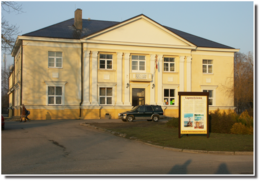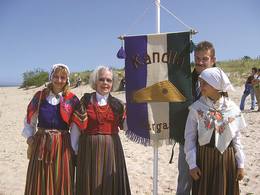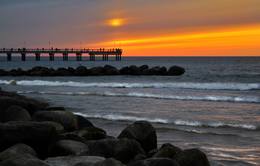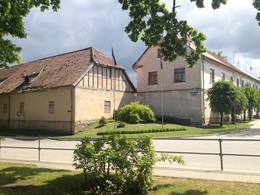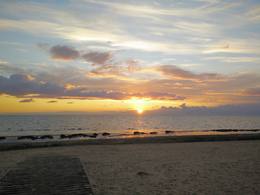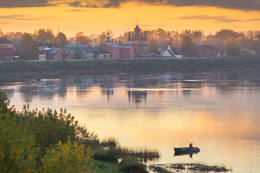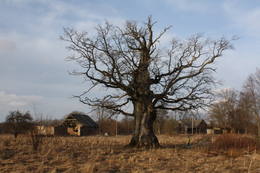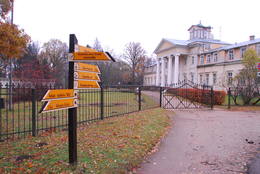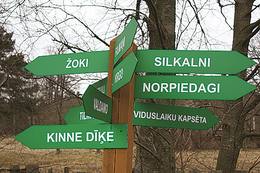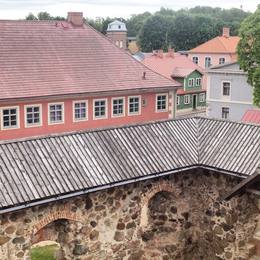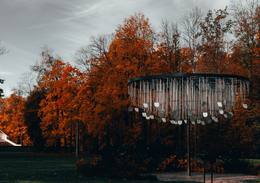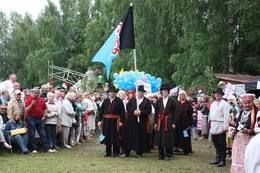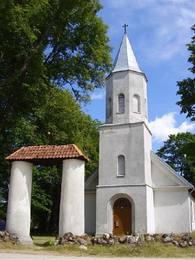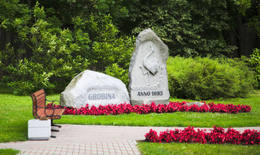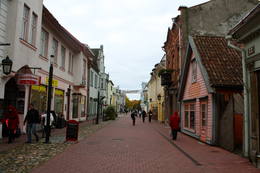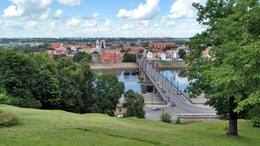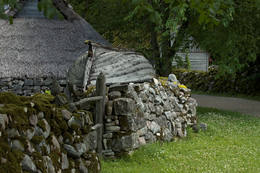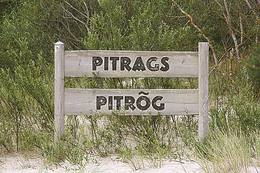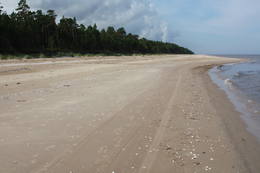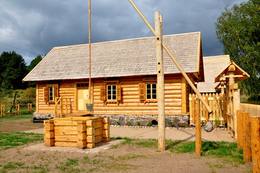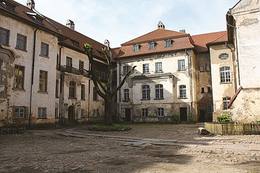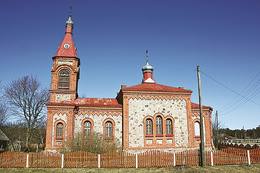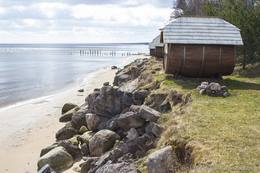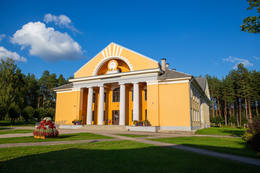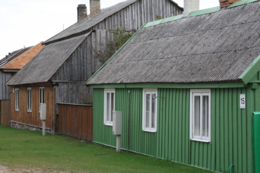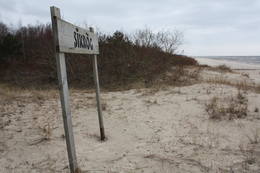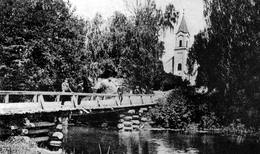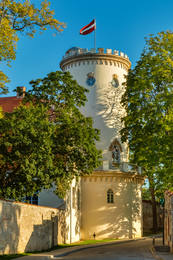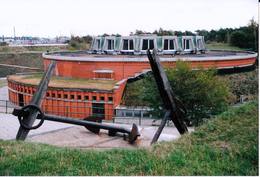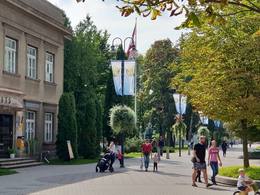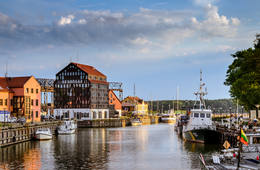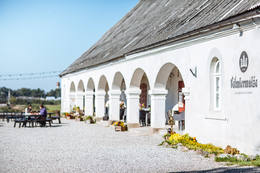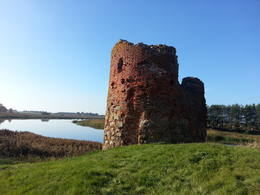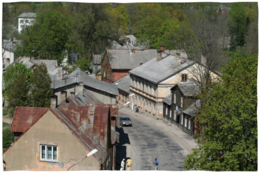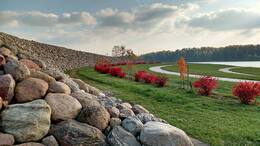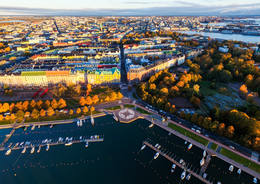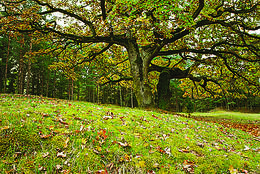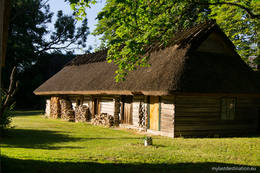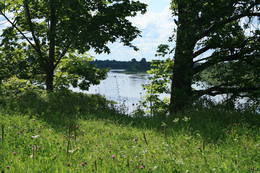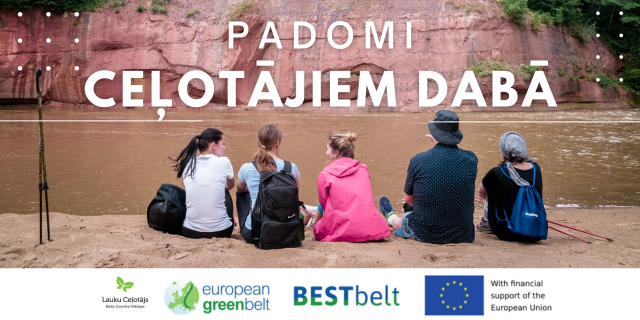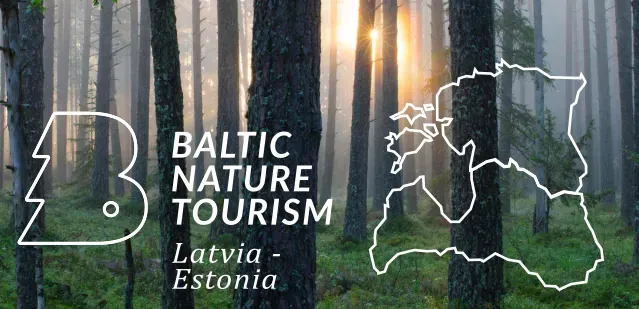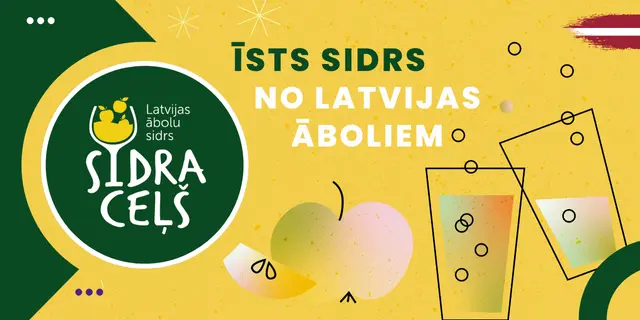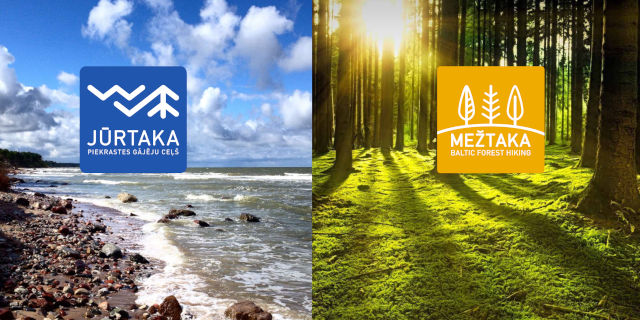Исторические и современные центры
| Обзор | Подробности |
|---|---|
|
Латвия
ЛАПМЕЖЦИЕМСХотя во время Первой мировой войны из 104 сельских домов было разорено 97, в тридцатые годы XX столетия Лапмежциемс быстро оправился, и здесь действовал один из мощнейших рыбацких кооперативов латвийского побережья. В советское время здесь был создан один из крупнейших рыболовецких колхозов «Селга», корпуса которого видны около устья Силиньупе. Современный Лапмежциемс – это излюбленный дачный район, место отдыха и купания. Интерес для туристов представляет памятник истории рыболовства - Лапмежциемский лодочный причал - бывшая пристань для рыбацких лодок, где рыбаки строили будки для сетей и хранили инвентарь. Между улицей Пиладжу и левым берегом Силиньупе за 3 - 2 тысячи лет до Рождества Христова находилась стоянка рыбаков и охотников, на месте которой установлен памятный камень. Это известное древнейшее поселение человека на территории национального парка «Кемери». Часть находок, обнаруженных при раскопках, можно увидеть в Лапмежциемском музее, где создана краеведческая экспозиция и собраны материалы о боях финских егерей в окрестностях Клапкалнциемса. |
|
|
Литва
Paluse (Palusė)Palūšē atrodas nacionālā parka administrācija (izveidota neliela ekspozīcija) un tūrisma informācijas centrs, kempings, nesen atjaunotā laivu bāze un viens no biežāk apmeklētajiem parka objektiem – Palūšes baznīca (Palūšės bažnyčia), kas celta 1757. gadā. 2008. g. No dievnama apkārtnes paveras jauks skats uz Lūšu (Lūšiai) ezeru, īpaši saulrietos, kad baznīca iegūst teiksmainu nokrāsu. Blakus baznīcas žogam aug vecais Palūšes ozols. Uzskata, ka tā vecums varētu būt ~ 350 – 400 gadi. |
|
|
Латвия
МазирбеВ документе 1387 года упоминается как «Малая Ирва» (Minor Irva). До середины 20-го века Мазирбе было самым крупным поселением ливов на побережье Курземе - рыбацкая деревня и центр судоходства. В селе была церковь, школа, аптека, лесное хозяйство, несколько магазинов, контора почты и телеграф, станция, лесопилка, парикмахерская, пекарня, фотостудия. В Браусках действовала печь по обжигу кирпича. В 30-е годы 20-го века рыболовный кооператив построил цех по переработке рыбы. В 1923 году здесь был основан Союз ливов и в 1939 году был открыт Народный дом ливов. Напротив него находятся Стуриши (родовое поместье семьи Тайзелей), где можно осмотреть предметы обихода ливов и, по предварительному заказу, продегустировать местные блюда. В Мазирбе проживали первые председатели Союза ливов - Карлис Сталте и Мартиньш Лепсте. Деятель культуры Карлис Сталте (1870 - 1978) долгие годы был пономарем и органистом в Мазирбе, а Мартиньш Лепсте был учителем ливского языка в 30-е годы 20-го века. Снаружи можно осмотреть здание бывшей Морской школы, где в период с 1894 по 1914 год образование получило около 2000 студентов. В советское время здесь находился армейский пост - застава. |
|
|
Латвия
ЮрмалциемсОдно из сравнительно редких мест, где на побережье можно понаблюдать за рыбаками в работе. Ветряная мельница «Клаюми» (1930 г.) является одним из самых высоких сельских строений. Рядом с мельницей находится Юрмалциемский Туристический информационный пункт, информационный стенд и место для отдыха.Здесь же видны старые деревянные корпуса барж, брошенных рыбаками. Экспозиция«Старинные предметы жителей Юрмалциемса» находится в восточной части поселка, где в деревянном сарае представлены собранные местными энтузиастами предметы быта и орудия труда окрестных жителей. |
|
|
Литва
PalangaPalanga is known to be the biggest by-the-sea resort in Lithuania because of its seacoast's main attractions - dunes and white sand. And because Palanga is a resort there are plenty of cafes, restaurants, bars and more for those who would like to enjoy a meal or a drink, for those who like active sport - there is possibility to cycle, go horseback riding, swim and much more. |
|
|
Латвия
АлсунгаКак древняя Альшванга этот населенный пункт был впервые упомянут в 1231 году в договоре папского вице-легата Балдуина Альнского с куршами. Ливонский орден управлял здесь до 1561 года, а с 1573 по 1738 год замок ордена перешел к происходящей из Померании семье Шверина. Именно во время правления семьи Шверинов в Алсунге был воздвигут каменный храм в честь святого архангела Михаила и начато обращение местных жителей в католичество. Алсунга становится центром католической церкви в Курземе, ее обитатели - суйтами (свита Шверинов). |
|
|
Латвия
ТУКУМСВ исторических источниках Тукумс упоминается в договоре 1253 года Ливонского ордена и епископа о разделе Курсы. Если название города переводить с ливского языка, то получается «кучи песка, горы». В начале XIV столетия рядом с каменным замком Ливонского ордена образовалось поселение немецких торговцев и ремесленников, расцвету которого способствовала близость дороги Рига - Пруссия. Позднее на развитие города существенно повлияло строительство в 1877 году железной дороги Рига – Тукумс. В советское время у восточных ворот Тукумса был построен крупнейший в Балтии военный аэродром СССР и военный городок. Современный Тукумс является краевым центром с таким же названием и широким спектром предлагаемых туристических услуг. |
|
|
Латвия
Исторический центр КраславыЦентральной части Краславы, для которой характерна красивая невысокая деревянная застройка, присвоен статус памятника культуры. Лучшие виды на исторический центр города открываются с автостоянки у тропы Адамова, горы Карницкого, прилегающей территории к мосту через Даугаву (улица Проспекта) и смотровой вышки Приедайне на левом берегу Даугавы. |
|
|
Латвия
СаулкрастыКак большое населенное место Саулкрасты начало образовываться в конце 19-го века, когда маленькие рыбацкие поселки – Нейбаде, Петерупе и Катринбаде стали популярным местом для отдыха и купания жителей Риги. Это вскоре поспособствовало строительству дач. На развитие курорта также повлияло открытие водного сообщения между Ригой и Саулкрасты в 1905-м году. Были построены новые курзалы, рестораны и развивалась другая инфраструктура, связанная с курортом. В летнее время отдыхающие могли развлечься на мероприятиях, баллах и концертах с участием рижских оркестров. Следующим этапом развития курорта стало шоссе и железнодорожная линия между Ригой и Саулкрасты, построенные в 30-х годах 20-го века. Советское время охарактеризовалось строительством домов отдыха, санаториев и новыми дачными домиками. Саулкрасты получают статус города. Сегодня Саулкрасты привлекают не только белым песчаным пляжем, но и различными ежегодными общественными мероприятиями, тропой Солнечного заката и Белой дюной, уникальным музеем велосипедов, Морским парком и местом для купания «Центр», площадью Саулес и другими объектами. |
|
|
Латвия
JaunpilsРазвитие Яунпилса связано с замком Ливонского ордена, который до наших дней почти не поменял свой внешний облик и строительный объем. В период с 1561 по 1919 гг. замок принадлежал роду баронов Реку. В 1905 году замок был сожжен, но позднее восстановлен под руководством архитектора В. Бокслафа. Более существенные реставрационные работы в замке начались в 60-х годах XX столетия. Сейчас в замке есть музей, а гурманы могут отведать пищу средневековья в таверне замка. |
|
|
Латвия
СмардеСмарде - старинное место, которое упоминается в документах XIII века. В наши дни - это небольшой поселок с железнодорожной станцией и магазином. К северо-востоку от Смарде, в Смардском болоте находится бывшее место добычи торфа. В Первую мировую войну недалеко от Смарде проходила линия фронта, о чем свидетельствуют находящиеся в окрестностях места памяти. |
|
|
Латвия
ВентспилсБлижайший к берегу ливов город, в котором действует Вентспилсское отделение Сообщества ливов, ансамбль ливов «Рандалист» («Rāndalist»), а в соседнем Таргале – ансамбли ливов «Кандла» («Kāndla») и «Пишки кандла» («Piški kāndla»). |
|
|
Эстония
Tartu vecpilsētaIzvietojusies Emajõgi upes kreisajā krastā, Doma kalna piekājē. Klasicisma stilā celtās vecpilsētas centrālā vieta ir Rātslaukums ar Rātsnamu un strūklaku „Studentu skūpsts” (pilsētas simbols). |
|
|
Latvija
PriekuleVēstures avotos pirmoreiz minēta 1483. g. Pilsētas uzplaukums bija vērojams pēc dzelzceļa uzbūvēšanas 19. gs. beigās, kad barons Korfs sadalīja un iznomāja apbūvei muižas zemi. Pilsētas tiesības Priekule ieguva 1928. g. Pilsēta smagi cieta 2. pasaules kara pēdējos mēnešos, - t.s. Kurzemes katla laikā, kuru laikā tika sagrautas 410 no 450 ēkām. Mūsdienās tā ir neliela pilsētiņa ar mazstāvu apbūvi un nesteidzīgu dzīves ritmu. |
|
|
Latvija
Ludzas vēsturiskā apbūveMazstāvu koka dzīvojamo ēku apbūve ir tapusi 19. gs. Te apskatāmi Latgalei raksturīgie noslēgtie pagalmi, verandas, koka apdare un dekori. Pilsētas koka apbūve ievērojami cieta 1866. un 1938. g. ugunsgrēkos. Par Ludzas vēsturisko centru var uzskatīt Tirgus laukuma vietu, bet Ludzas pilskalnu - par galveno dominanti, kuram apkārt veidojies pilsētas ielu tīkls. Ludzas pilskalnā slejas Ludzas pilsdrupas. 14. gs. beigās te atradās seno latgaļu koka pils, kuras vietā Livonijas ordenis uzcēla Latgales varenāko mūra pili. 1654. g. to izposta Krievijas cara Alekseja Mihailoviča karaspēks. Ludzas TIC gidi piedāvā ekskursijas. |
|
|
Lettland
AinaziDer Name Ainaži ist untrennbar von der lettischen Seefahrtsgeschichte. Im Jahr 1864 wurde hier die erste Seefahrtsschule gegründet, in der auch die Kinder der lettischen Bauern lernen konnten. Es ist gesetzmäßig, dass Ainaži zu einem bedeutenden Zentrum für den Bau von Schiffen für Küstenschifffahrt und zu einem Hafen wurde. Das wirtschaftliche Leben der Stadt hat die im Jahr 1913 eröffnete Schmalspurbahnlinie Smiltene-Valmiera-Ainaži begünstigt. Heute ist die Stadt Ainaži eine kleine und stille lettische Stadt, die mit mehreren interessanten Sehenswürdigkeiten an der Grenze zu Estland liegt. |
|
|
Lettland
Madonas Saieta laukumsMadonas centrālais laukums, kas vēl 20. gs. sākumā bija tirgus laukums. Pēc apjomīgās restaurācijas tas ir kļuvis par ievērības cienīgu pilsētvides objektu. Laukuma ziemeļu pusē atrodas pilsētas un novada pašvaldība un Madonas novada TIC. |
|
|
Lettland
The historical centre of TalsiThe historical centre of Talsi, which is known as the town of nine hillocks. The historical construction around Baznīckalns hill, Lake Talsi and Lake Vilkmuiža mostly dates back to the 19th century. Lielā Street is particularly beautiful with its low-rise buildings (two or three floors and ridged roofs). There are beautiful views from the area around Lake Talsi and Ķēniņkalns hill. |
|
|
Lettland
Cesis Der Ursprung der Stadt ist auf dem 18m hohen Riekstu kalns (Nussberg) und dessen Umgebung zu suchen, denn im 11. -13. Jh. befand sich hier die Holzburg Venden. Der Nussberg befindet sich in der Mitte des Burgparks, von dort hat man eine schöne Aussicht auf den Park, den Weiher und die Burgruine von Cēsis , wohin man gelangt, wenn man die lange kaskadenartige Treppe hinuntersteigt. Die im 13. Jh. gebaute Burg von Cēsis war Residenz des Ordensmeisters und eine der stärksten Ordensfestungen im gesamten Baltikum. Daneben befindet sich das neue Schloss, das 1777 an der Stelle der Torbefestigungen erbaut worden ist. Das Gebäude beheimatet das Museum für Geschichte und Kunst der Stadt, in einem Anbau befindet sich das Besucherzentrum des Schlosses und das Touristikinformationszentrum von Cēsis. Wenn man den Turm besteigt, hat man Aussicht auf die Burgruine, auf die lutherische Kirche und den Nordteil der Stadt. Gegenüber des neuen Schlosses gibt es noch mehrere Gebäude – den Stall und den Wagenunterstand des Schlosshofes (beide Gebäude wurden Anfang des 19. Jh. gebaut), wo heute das Ausstellungshaus Cēsis (Cēsu Izstāžu nams) eingerichtet ist. Auf dem Schlossgelände kann man von außen noch die Scheune, das Kutscherhäuschen sowie die alte Bierbrauerei sehen. Auf der gegenüberliegenden Seite der Straße befindet sich der romantische Mai-Park (Maija parks), der in den 30er Jahren des 19. Jh. angelegt worden war. Begibt man sich weiter in die Straßen der Stadt (Lielās Katrīnas, Mazās Katrīnas, Mazā Kalēju, Kalēju, Lielā Līvu iela un Līvu laukums), kann man Holzbauten des 18. und 19. Jh. sehen. In der Torņa ielā (Turmstraße), die entlang der Schutzmauer der mittelalterlichen Burg verläuft, kann man an der Kirche die Skulptur mit dem Namen „Durch die Jahrhunderte“ von Matthias Janson sehen. Der Sage nach kann man, wenn man die Laterne des Nachtwächters reibt, in die Zukunft sehen. |
|
|
Lettland
PiedrujaDie größte Ortschaft im Südosten Lettlands, die vom Süden vom Fluss Daugava umgeströmt wird. Der Fluss ist gleichzeitig die Grenze zwischen Lettland und Weißrussland. Die Mitte des Flusses ist die Grenze zwischen zwei Ländern. Piedruja besteht aus zwei Teilen – Piedruja und Aleksandrova, die von der Zentralstraße (Straße V 631 ) getrennt sind. Piedruja hat sich als ein gegenüberliegendes Territorium der Stadt Druja entwickelt, die sich am linken Daugava-Ufer befindet. Zwei Teile gehörten im 17. Jahrhundert dem Hochadelgeschlecht Sapieha des Großfürstentums Litauens. Die Häuser mit wenig Stockwerken von Druja und eine zerstörte Kirche sind gut vom Piedruja-Ufer zu sehen. Es lohnt sich, Piedruja und die Umgebung, zu Fuß zu gehen, weil die Holzhäuser mit wenig Stockwerken stellenweise an die Häuser in den Freilichtmuseen erinnern. Piedruja sieht gepflegt aus, zwischen zwei Kirchen ist ein malerischer Garten angelegt. Mit bedeutenden Objekten – mit zwei Kirchen und Daugava-Stein macht der Piedruja-Pfad bekannt. Im Teil Aleksandrova befindet sich das Hotel „Piedruja”, das ein besonderes touristisches Produkt anbietet – eine Abendunterhaltung im lettgallischen, russischen und weißrussischen Stil. Vor der Reise nach Piedruja muss man die Aufenthaltserlaubnis fürs Grenzgebiet erhalten. Eine Grenzkontrollstelle befindet sich in Piedruja am Daugava-Ufer, wo noch relativ vor nicht langer Zeit eine der Überfahrten über den Fluss Daugava in Betrieb war. |
|
|
Lettland
JurkalneDer frühere Name von Jūrkalne war Felixberg, der übersetzt den glücklichen Berg bedeutet. Den heutigen Namen hat die Ortschaft im Jahr 1925 bekommen. Heute ist Jūrkalne nicht nur ein beliebter Ort von Touristen (die Steilküste von Jūrkalne), aber auch einer der seltenen Orte der Welt, wo man die Blauen Kühe besichtigen kann. |
|
|
Lettland
Riga, Altstadt (Vecriga)Die Hauptstadt Lettlands. Die Altstadt Rigas ist in die UNESCO Liste des Weltkulturerbes aufgenommen worden. Die Jugendstilperle Europas. Die ehemalige Hansestadt. |
|
|
Lettland
KandavaZum ersten Mal ist der Name von Kandava in den schriftlichen Quellen im Jahr 1230 erwähnt worden. Im Jahr 1253 hat der Livländische Orden auf dem steilen Ufer des Urstromtales des Flusses Abava eine gemauerte Burg gebaut, an deren Fuß sich eine Siedlung herausgebildet hat. Im 17. Jh. wurde Kandava zu einem bedeutenden Handelszentrum. Die Stadt und ihre Einwohner haben schwer unter der Pest und den Ereignissen des Ersten Weltkriegs gelitten. Die Stadtrechte hat Kandava im Jahr 1917 erlangt. Während der Sowjetzeit wurde der Sportkomplex der Landwirtschaftlichen Fachschule von Jaunkandava zu einem bekannten Ort für Training. |
|
|
Lettland
Das Bauskaer RathausBereits 1615 teilte der kurländische Herzog Friedrich Kettler der Stadt Bauska das Privileg für den Bau eines neuen Rathauses zu, was dann im 17.Jh. auch verwirklicht wurde. Der Marktplatz konnte nun stolz das größte Rathaus im ganzen Herzogtum vorweisen. Aus Geldmangel wurde 1852 dessen Turm abgebaut, 1871 das obere Stockwerk. 2011 wurde der Bau des neuen Rathauses endlich abgeschlossen, und Bauska kann nun wieder stolz auf ein neues, hervorragendes Touristik-Objekt sein, das auch von innen besichtigt werden kann. Im erneuerten Rathaus kann man sich in alten Maßeinheiten messen und wiegen lassen, in Ellen und Fuß, in Pud (ein altes russisches Gewichtsmaß, A.d.Ü.) und in Pfund, und dafür eine entsprechende Urkunde erhalten. |
|
|
Lettland
Der MichelsturmFrüher Pize, livisch Pizā. Der jetzige Name stammt von dem während der Kaiserzeit erbauten Leuchtturm (Michailowski Majak), der im Namen des Neffen des alten Kaisers Alexander II. genannt wurde. Der heute bestehende Leuchtturm – insgesamt der dritte – Miķeļbāka wurde 1957 erbaut und ist der höchste Leuchtturm in Lettland : 57 m hoch (nur von außen zu besichtigen). Die lutherische Kirche von Miķeļtornis wurde 1893 erbaut. In der Nähe kann man das 1857 erbaute Gebäude des Wirtshauses von Pize (in schlechtem Zustand) mit der für das 19. Jahrhundert typischen Planung und Konstruktion sehen, das als einziges an der Livischen Küste gilt. In Miķeļtornis wurde der erste livische Kulturarbeiter Jānis Princis (1796–1868) geboren, der zusammen mit seinem Sohn Jānis das Evangelium nach Matthäus in den westlichen Dialekt der kurländisch-livischen Sprache übersetzt hat. J. Princis Senior und J. Princis Junior waren auch Autoren der 1845 herausgegebenen Dichtung „Geistliche Lieder und Gebete der Seemänner“. Vorher wurde ein lettisches Dichtungsbuch nur vom Blinden Indrick herausgegeben. Auf dem Bauernhof Olmaņi in Miķeļtornis wird ein Schüler des Künstlers Vilhelms Purvītis, der livische Maler Andrejs Šulcs (1910–2006), geboren. Auf dem Friedhof von Miķeļtornis wird 1978 ein Denkmal für livische Dichter (das erste Denkmal für Liven) eröffnet. Es ist geplant, bis 2019 im Dorfzentrum das Kunstobjekt des Künstlers Ģirts Burvis „Jahrhundert der Segelschiffe“ zu eröffnen. |
|
|
Litauen
VisaginasEntstanden als eine 6 km entfernte Arbeiterstadt des schon geschlossenen Ignalina-Atomkraftwerks. In der Stadtbebauung dominieren die für die Sowjetzeit typischen architektonischen Formen und Monumentalbauten. |
|
|
Lettland
Jekabpils / KrustpilsKrustpils wurde das erste Mal 1237 in Zusammenhang mit einem Bau der Kreuzburg am rechten Daugava-Ufer historisch erwähnt. 1511 wurde Krustpils als eine Ortschaft erwähnt. 1585 hat der König von Polen Stephan Báthory die Ortschaft Krustpils dem Nikolaus von Korff geschickt und gehörte Krustpils den Baronen von Korff bis 1920. 1626 geschahen nahe Krustpils die Schlachten zwischen schwedischen und polnischen Truppen. Die ruinierte Ortschaft hatte keine Entwicklung bis zum 19. Jahrhundert. Seinerseits wurde Jēkabpils in der Mitte des 17. Jahrhunderts als eine Siedlung der verfolgten Altgläubigen aus Russland – Sloboda gegründet. Auf dem Fluss Daugava befinden sich gegenüber Krustpils un Jēkabpils die Flussschnellen, deswegen mussten die Flößer anhalten und die Waren auf die Fuhren verladen. Demzufolge blühte die Siedlung auf und 1670 verlieh die die Stadtrechte und den Namen Jēkabpils zu Ehren des Herzogs von Kurland. 1861 begann das Aufblühen von Krustpils nach der Eröffnung der Eisenbahnstrecke Rīga – Daugavpils und endete sich von Jēkabpils. 1962 wurden Krustpils und Jēkabpils zu einer Verwaltungseinheit mit dem Namen Jēkabpils. Bis heutzutage sind in Jēkabpils eine für das 19. Jahrhundert typische einstöckige Holzbebauung, die um die Wende des 19. und 20. Jahrhunderts errichteten Gebäude aus rotem Stein, Kirchen von sieben verschiedenen Konfessionen erhalten geblieben. Einer das linke Daugava-Ufer umschließende Schutzdamm (Anfang des Baues 1861) wurde mit dem Ziel gebaut, die Stadt von Überflutungen zu schützen. Heutzutage ist der Damm zu einer Promenade umgebaut, die ein beliebter Platz der Bewohner für Spaziergänge und Erholung ist. |
|
|
Lettland
VidaleEine kleine Ortschaft mit einer Schule, einer Bibliothek und einem Geschäft. Nördlich von Vīdale kann man die Reste einer Windmühle besichtigen. Wenn man die Richtung Rigaer Bucht nimmt, kreuzt die Straße die Blauen Berge von Šlītere mit Sandsteinwänden und mit eindrucksvollen Aussichten in den Jahreszeiten, wenn die Bäume keine Blätter haben. Auf der linken Seite kann man die Quelle der Blauen Berge sehen, wo eine Stelle zum Wassernehmen eingerichtet ist. Die Straße, die von Vīdale nach Melnsils führt, nennen die Einheimischen den Damm Knipeldambis. Die Straße soll von der Deutschen Armee während des Ersten Weltkriegs gebaut worden sein, indem auf dem Weg Rundhölzer gelegt und mit Kies beschüttet wurden. |
|
|
Lettland
DagdaDagda ist in den historischen Quellen im 17 Jh. als eine Ortschaft der Händler erwähnt worden. Im Jahr 1772 wurde der Kreis von Dagda dem Gouvernement Pleskau, aber im Jahr 1802 – dem Gouvernement Witebsk hinzugefügt. Im Jahr 1905 fanden hier große Bauernaufstände statt, während denen viele bedeutsame Baudenkmäler zerstört wurden. Die Stadt wurde auch von den beiden Weltkriegen nicht geschützt. Was kann sich der Reisende hier anschauen? Im Zentrum von Dagda hat sich die historische Bebauung aus dem 20. Jh. erhalten. Diese Bebauung bilden die sogenannten Häuser der jüdischen Händler, die aus roten Ziegeln gebaut wurden. Dagda ist der einzige Ort in Lettland, wo jedes Jahr im Stadtpark der Anna-Tag gefeiert wird! |
|
|
Litauen
JuodkrantėEin altes Fischerdorf, das schriftlich 1429 erwähnt wurde. Heute – ein populärer Kurort. |
|
|
Lettland
Mittelalterliche Burg von KokneseDie Geschichte von Koknese ist mit dem Bau der gemauerten Burg des Bischofs im Jahr 1209 an dem Zusammenfluss der Flüsse Daugava und Pērse verbunden. Die Burg von Koknese war ein bedeutender Kontrollpunkt auf dem Wasserweg Daugava, der nicht besetzt bis zum Jahr 1701 bestand, als die Burg von dem sächsischen Heer gesprengt wurde. Bis zur Bildung des Stausees des Wasserkraftwerks von Pļaviņas befand sich an diesem Ort der Felsen von Daugava, der einer der landschaftlich schönsten und von den Touristen am meisten besuchten Orte in Lettland war. Nördlich von den Burgruinen befindet sich der im Jahr 1900 eingerichtete Park von Koknese mit mittelalterlichen Friedhofsdenkmälern und schwedischen Kanonen aus dem 17. Jh. Die Reisenden können hier die Burg besichtigen, eine Bootsfahrt unternehmen, sowie mittelalterliches Geld prägen. |
|
|
Lettland
IecavaEine kleine Stadt unterwegs von Riga nach Bauska. Der Name der Stadt ist in den schriftlichen Quellen im Jahr 1492 erwähnt worden. Hier kann man die evangelisch-lutherische Kirche und den Park des ehemaligen Landgutes besichtigen. |
|
|
Lettland
BauskaDer Name von Bauska ist in den historischen Quellen zum ersten Mal 1443 erwähnt worden. Das ist die Zeit, als auf der Halbinsel zwischen den Flüssen Mūsa und Mēmele mit dem Bau der Burg begonnen wurde, die die letzte Burg des Livländischen Ordens auf dem Gebiet Lettlands war. An der Burg – auf der Insel Ķirbaksala hat sich die Ortschaft Vairogmiests herausgebildet. Im 17. Jh. blühte die Stadt schnell auf. Hier arbeiteten Goldschmiede, Silberschmiede, Tischler, Töpfer, Schuhmacher und andere Handwerker. In den späteren Jahrhunderten haben die Einwohner der Stadt unter Kriegen, unter der Pest und der Napoleonischen Armee gelitten. Heute ist die Altstadt von Bauska mit ihrem neu gebauten Rathaus und mit der erneuerten Burg von Bauska eines der interessantesten historischen Zentren der lettischen Städte. Bauska ist mit ihren jährlichen Veranstaltungen bekannt: Mit dem Festival der Alten Musik, dem Stadtfest von Bauska, dem Festival der Countrymusik u.a. |
|
|
Lettland
JelgavaDie bedeutendste Periode der Stadt ist mit der Zeit von 1561 bis 1795 verbunden, als der Kreis von Jelgava dem Herzogtum von Kurland und Semgallen gehörte. Als Jelgava zur Residenz des Herzogs (1567) und zur Hauptstadt des Herzogtums (1616) wurde, blühte die Stadt schnell auf. Der höchste Punkt der Entwicklung war in der Regierungszeit des Herzogs Jacob. In der Regierungszeit der letzten zwei Herzoge – Ernst Johann von Biron und seines Sohnes Peters – wurde die Academia Petrina (1775) – die erste Hochschule in Lettland – gegründet, im Jahr 1816 wurde die Gesellschaft für Literatur und Kunst gegründet, im Jahr 1822 wurde die erste lettische Zeitung Latviešu Avīzes veröffentlicht, im Jahr 1802 wurde das erste Theatergebäude, aber im Jahr 1898 – das erste Museumsgebäude in Lettland gebaut. Im Jahr 1937 zog im Schloss von Jelgava die Lettische Landwirtschaftskammer ein, aber in zwei Jahren wurde die Landwirtschaftliche Akademie von Jelgava geöffnet. Im Sommer 1944 wurden fast die ganze historische Bebauung und die Kunstwerte der Stadt zerstört. Nach dem Zweiten Weltkrieg wurde Jelgava erneuert. Vor einer kurzen Zeit wurde auch der Turm der Heiligen Dreieinigkeitskirche erneuert, wo zurzeit eines der besten interaktiven Museen in Lettland (kinder- und familienfreundlich) eingerichtet ist. |
|
|
Lettland
KrimuldaDie evangelisch-lutherische Kirche von Krimulda wird als eines der ältesten Gotteshäuser von Lettland angesehen. Die Anfänge der Kirche sind im Anfang des 13. Jhs. gleich nach der Eroberung von Kubesele zu suchen, später wurde die Kirche mehrmals umgebaut. Neben der Kirche ist das Labyrinth für Meditationen Lilijas zieds (Lilienblüte) eingerichtet. Als im Jahr 1217 im Kampf von Viljandi der livische Häuptling Kaupo gefallen ist, wurden seine Aschen laut Erzählungen in der Kirche beigesetzt. Als die Grabstätte von Kaupo wird im Volke ein kleiner Hügel neben dem kleinen Fluss Runtiņupīte (Runtiņš) genannt, an dessen rechten Ufer sich die ungefähr 7 m lange und künstlich gegrabene Höhle Kubeseles ala (Runtiņala) befindet. Am linken Ufer des Flusses Runtiņupīte erhebt sich der Burgberg von Kubesele. An der Kirche beginnt der Naturpfad von Kubesele. Wenn man den Pfad folgt, gelangt man bis zum Fluss Gauja, an dessen Ufer der Stein Lielais (Runtiņa) akmens liegt. Hier kann man auch die von den Flößern von Gauja aufgestellten Ankerklötze besichtigen. Die mittelalterliche Burg von Krimulda (4 km östlich von der Kirche von Krimulda) wurde in der zweiten Hälfte des 13. Jhs. an der Stelle gebaut, wo der Grundufer des Urstromtales von Gauja von dem Tal Vikmestes grava durchgespaltet wird. Die Burg, in der das Domkapitel von Riga – der Rat der Erzbischöfe von Riga – gewirtschaftet hat, war ein eindrucksvolles Gebäude, dessen breiter Innenhof von einer 1,5 m dicken Schutzmauer eingeschlossen war. Im Jahr 1601 hat der schwedische Feldherr Heinrich von Lieven die Burg beim Zurückziehen gesprengt. Heute kann man auf dem von den Wäldern bewachsenen Hügel einige Burgreste besichtigen. Neben den Burgresten befindet sich die Luftseilbahn und beginnt der Serpentinweg von Krimulda. Unweit befindet sich das Landgut von Krimulda, das in den schriftlichen Quellen zum ersten Mal schon im 15. Jh. erwähnt worden ist. Das heutige Schloss des Landgutes wurde im 19. Jh. im Neoklassizismus (der Inhaber – Baron on Lieven) gebaut. In den 1920er Jahren gelang das Schloss nach der Enteignung im Eigentum des Roten Kreuzes, das dort ein Sanatorium für Kinder eingerichtet hat. Heute befindet sich in diesem Schloss das Rehabilitationskrankenhaus Krimulda, aber von den wirtschaftlichen Häusern des Landgutes haben sich die Ställe, das Haus der Diener und der Verwalter und das sogenannte Haus der Schweiz, sowie der Park erhalten. Hier werden thematische Führungen angeboten. Wenn man eine Bootsfahrt auf dem Fluss Gauja unternimmt, kann man in der Nähe die 15 m hohe Steilwand Velnalas klintis (Felsen der Teufelshöhle) besichtigen. Die Steilwand kann man sehr gut auch aus dem anderen – dem linken – Ufer des Flusses Gauja besichtigen, wo ein Picknickplatz eingerichtet ist. In der Mitte der Steilwand befindet sich die ungefähr 19 m tiefe und 4,7 m hohe Höhle Velnala (Teufelshöhle) von Krimulda. Wenn wir von dieser Steilwand das rechte Grundufer des Flusses Gauja Richtung Turaida am unten gehen, können wir die Sandstein-Steilwand von Piķene besichtigen. Unten an der Steilwand ist der ungefähr 1 km lange Biberpfad von Piķene eingerichtet. Am Rande des Pfades befindet sich die 5 m lange Höhle Mazā Velna ala (die kleine Teufelshöhle) mit der Quelle Gudrības avotiņš (Quelle der Weisheit), sowie die genauso lange Höhle Aunapieres ala. Hier kann man auch einige zugewachsene Nebenflüsse sehen. |
|
|
Латвия
САБИЛЕНа месте городища Сабиле уже в X веке находился древний укрепленный город. После раздела земель куршей, Сабиле отошло к Ливонскому ордену, который построил каменный замок (не сохранился). В письменных источниках Сабиле впервые упоминается в 1253 г. В XV веке вокруг замка начало образовываться поселение. Права города Сабиле получил в 1917 году. Теперешний Сабиле - небольшой провинциальный городок, в окрестностях которого находятся многие известные культурно-исторические памятники. Неотъемлемая составная часть культурной среды города Сабиле - цыгане, поэтому город в простонародье зовется цыганской столицей Латвии. Сабиле издавна известен своими традициями выращивания виноградной лозы и виноделия, которые возрождаются и которыми наслаждаются во время Сабилского праздника вина. |
|
|
Литва
Dorf StripeikiaiDas bekannteste Museum der Geschichte der Bienenzucht Litauens mit den Bienenhäusern verschidener Arte, der Arbeitsmittel der Bienenzüchter, Holzskulpturen und Hönigankauf. |
|
|
Latvija
Košrags (Kuoštrõg)Košragu uzskata par jaunāko lībiešu jūrmalas ciemu (veidojies 17. gs.). 1826. g. Košragā bija 78 iedzīvotāji. 1832. g. Žokos atvēra Dundagas jūrmalas ciemos pirmo lasītmācīšanas skolu lībiešu bērniem, kur par skolotāju strādāja pirmais profesionālo izglītību ieguvušais lībietis Nika Polmanis, kurš austrumu izloksnē iztulkoja Mateja evaņģēliju. Košragā bija vējdzirnavas, ūdensdzirnavas, laivu būves vieta. Pavasaros te piestāja laivas ar darba meklētājiem no Sāmsalas. 1932. g. izbūvēja ostu, 1938. g. - molu mudas (jūras mēslu) vākšanai. Pagājušā gs. 30. gados Košragu regulāri apmeklēja somu un igauņu valodnieki, kuri te savāca visvairāk lībiešu folkloras vienību. Norpiedagu mājas cēla lībiešu sabiedriskais darbinieks - Didriķis Volganskis (1884 - 1968). Tur piedzima viņa dēls - lībiešu kultūras darbinieks, mācītājs (Somijā) Edgars Vālgamā (Volganskis, 1912 - 2003), kurš lībiski pārtulkoja A. Pumpura eposu „Lāčplēsis” somu valodā. Mūsdienās Košrags ir valsts nozīmes kultūras piemineklis. |
|
|
Latvija
LimbažiUzskata, ka Limbažu Ķezberkalniņā bijusi Metsepoles lībiešu novada pils Lemisele. Tāpat atrodamas ziņas, ka līdz pat 16. gs. no jūras pa Svētupi un Dūņezeru līdz šejienei braukuši tirgoņi. 1223. g. bīskaps Alberts Limbažos uzbūvēja mūra pili. Limbaži tāpat kā Valmiera kļuva par Hanzas savienības locekli. 16. gs. sākumā gan tās ekonomiskā loma ievērojami samazinājās, jo Svētupe un Dūņezers kļuva kuģniecībai neizmantojami. Laikā no 16. – 18. gs. pilsēta un pilsētnieki cieta no kariem, slimībām un ugunsgrēkiem. Tā rezultātā iedzīvotāju skaits sasniedza savu visliekāko kritumu – astoņi cilvēki. 19. – 20. gs. mijā un 20. gs. sākumā saimnieciskā dzīve atkal atjaunojas. |
|
|
Latvija
Sigulda,TuraidaSiguldas pils celtniecību uzsāka Zobenbrāļu ordenis 1207. g., bet 1236. g. to pārbūvēja Livonijas ordeņa vajadzībām. Siguldas pils stipri cieta 16. gs. otrās puses un 17. gs. sākuma karos. Ziemeļu kara laikā to nodedzina un vairāk neatjauno. Šodien ir apskatāms pils konventa ēkas dienvidrietumu korpuss un galveno vārtu tornis, aiz kura atrodas iekšējā priekšpils ar brīvdabas estrādi, no kuras paveras iespaidīgs skats uz Gaujas senleju. Dienvidos esošās Siguldas Jaunās pils celtniecība (īpašnieks - kņazs Kropotkins) norisinājās laikā no 1878. - 1881. g. No 1923. - 1940. g ēkā bija Rakstnieku pils, bet Padomju gados - kardioloģijas sanatorija. Kopš 2003. g. te atrodas Siguldas novada dome. Muižas kompleksā ir saglabājusies koka dzīvojamā ēka (19. gs. vidus), kurā atradās Kropotkina ģimenes mājas, klēts (18. - 19. gs. mija), dārznieka māja (19. gs.) un mūra žogs (19. gs.). Ja no Jaunās pils dosimies ziemeļaustrumu virzienā, pēc nepilniem 2 km nonāksim pie Vējupītes gravas. Tajā apskatāma seklā (3,6 m), bet augstā (6,1 m) Pētera ala un dziļā Pūču grava ar Kraukļupīti. Abu upīšu gravu saskares vietā paceļas Satezeles pilskalns (plakums 90 x 75 m), kur 13. gs. sākumā atradās līvu zemes vadoņa (vecākā) - Dabreļa ozolkoka pils. Netālu meklējama Kraukļu aiza - Vējupītes kreisā krasta sānu grava ar 11 m augstām smilšakmens sienām un 5,2 m dziļā Kraukļu ala. Vējupītes gravas un Gaujas senlejas saskares vietā slejas Paradīzes (Gleznotāju) kalns - ļoti ainaviska vieta, kas gleznota un fotografēta kopš seniem laikiem! Siguldas rietumdaļā var apmeklēt Panorāmas ratu (darbojas vasaras laikā) un Gaisa trošu ceļu (tramvajs) - Baltijas valstīs vienīgo (celts 1969. g.) šāda tipa transporta līdzekli. Tā nesošā trose stiepjas 1060 m garumā un bez atbalstiem savieno Gaujas senlejas krastus starp Siguldu un Krimuldu ~ 40 m augstumā virs Gaujas. Siguldas dienvidrietumu daļā var aizstaigāt līdz varenajai Beites kraujai, kuru pāršķeļ dziļa strauta grava. Gravas rietumu pusē meklējams Ķeizarskats, kas atrodas ~ 67 m virs Gaujas līmeņa ar labu skatu uz Krimuldu un Turaidas pili. Skatu vietu šeit iekārtoja jau 1862. g. kad Siguldā viesojies Krievijas cars Aleksandrs II. Gravas austrumu pusē novietots no koka veidotais Ķeizarkrēsls. Vietā, kur Gaujas senlejas labo pamatkrastu pāršķeļ vairākas mazu strautu dziļās gravas, izvietojies Turaidas muzejrezervāts ar Baltijas mērogā izciliem pieminekļiem, kuru vēsture iestiepjas 1000 gadu tālā pagātnē. Starp tiem ir jāmin Turaidas muiža (21 ēka), Turaidas Rozes kaps, Turaidas luterāņu baznīca (viena no vecākajām (1750. g.) Latvijas koka baznīcām) un Turaidas pils. Blakus esošajā Dainu kalnā tiek organizēti dažādi tematiski pasākumi. |
|
|
Latvija
BalviPirmo reizi Balvi kā apdzīvota vieta minēti 1224. g. 19.-20. gs. mijā Balvi kā muižas un pagasta centrs izveidojās par lielāku apdzīvotu vietu. Latvijas Brīvības cīņu laikā 1919. g. Balvi bija Latgales partizānu pulka izveides vieta.1926. g. Balvi ieguva miesta tiesības, bet 1928. g. kļuva par pilsētu. 2. pasaules kara laikā, vācu armija atkāpjoties, Balvus nodedzina gandrīz pilnībā. Balvēnieši lepojas, ka te saule lec par trīs minūtēm ātrāk nekā Rīgā. Arī pats pilsētas centra veidols pēdējos gados ir mainījies. |
|
|
Igaunija
Mulgimā vēsturiskais reģionsMulgimā jeb Mulgi ir kulturvēsturisks reģions Igaunijas dienvidos. Par Mulgimā tika uzskatīta Viljandi apriņķa daļa, kas atrodas uz dienvidiem no Raudnas un Tenasilmas upēm. Senākos laikos Mulgi lauksaimnieki bija slaveni ar savu aso prātu un mērķtiecību, kas palīdzēja pārpirkt zemes no vācbaltu muižniekiem un kļūt par bagātiem lauksaimniekiem. Mulgi kultūras ikonas - dialekts, labi zināmā vīriešu garā melnā jaka un tradicionālā Mulgi putra - ir saglabājušās līdz pat šai dienai.
|
|
|
Lietuva
Žemaišu Kalvarija (Žemaičių Kalvarija)Pirmo reizi vēstures avotos 1253. g. šī vieta ir minēta kā kuršu apdzīvota apmetne. Laikā no 1637. – 1639. g. te uzcēla pirmās 19 kapelas – t.s. „Krusta ceļa stacijas", kas atgādināja Jeruzalemes Krusta ceļu. Kopš tā laika Žemaišu Kalvarija ir pazīstama kā nozīmīgs svētceļnieku galamērķis. Dažas no Krusta ceļa kapelām ir veidotas 17. – 18 gs., bet citas – 19. gs. Jāatceras, ka vēl pavisam nesen – Padomju laikos svētceļniekus nežēlīgi vajāja un represēja. Mūsdienās pilsētā ir izveidots 21 svētceļnieku „pieturas punkts". Te ik gadu (parasti no 2. – 12. jūlijam) notiek Žemaišu Kalvarijas katoļu draudzes svētki, kas pulcina daudz ļaužu no dažādām Eiropas valstīm. Iespaidīgā katoļu bazilika ir slavena ar Vissvētākās Jaunavas Marijas Katoļu Ģimeņu Karalienes gleznu, kas 17. gs. atvesta no Romas. Tai piedēvē brīnumdarītājas spējas. Interesants ir pilsētas ielu tīklojums, kas atgādina 9. – 13. gs. apdzīvotas vietas ielu plānojumu. Noteikti apskatāms iespaidīgais Žemaišu Kalvarijas pilskalns, kas slejas mazās Varduvas (Varduva) upītes krastā. |
|
|
Latvija
LīgatneLīgatnes vēsture ir nesaraujami saistīta ar Līgatnes papīrfabriku. 19. gs. beigās un 20. gs. sākumā te uzcēla strādnieku dzīvojamās ēkas, skolu, dzemdību namu, slimnīcu, klubu, viesu namu un citas ēkas, kas ir saglabājušās līdz šodienai. Padomju laikā Līgatnes papīrfabrikā ražoja g.k. skolu burtnīcas, kuras sūtīja uz visām PSRS republikām. Mūsdienās galvenā izejviela ir makulatūra, no kuras ražo ietinamo papīru. Līgatnes papīrfabrika ir vienīgais šāda veida funkcionējošais uzņēmums Latvijā, un to var iepazīt vietējā gida pavadībā. Līgatnes papīrfabrikas vēsturiskajam centram ir piešķirts kultūras pieminekļa statuss. Līgatnes ziemeļdaļā – Gaujasmalā ir jāuzmeklē vienīgā mūsdienās funkcionējošā Gaujas pārceltuve un vienīgā upju pārceltuve Baltijā, kas darbojas ar straumes spēku. Pārceltuve ir vietēja mēroga transporta līdzeklis. Rietumos no Līgatnes atrodas Līgatnes dabas takas, kur dabiskai videi pietuvinātos apstākļos (Baltijā labākais šāda veida objekts) dzīvo staltbrieži, stirnas, mežacūkas, lapsas un lūši. Līgatnes dabas taku teritorijā ir izveidots blīvs pastaigu taku tīkls un asfaltēts auto – velomaršruts, kas ziemā top par distanču slēpošanas trasi. Te pieejams moderns apmeklētāju centrs. Austrumos no Līgatnes – Līgatnes rehabilitācijas centrā meklējama Eiropas mērogā unikāla vieta – bijušais slepenais padomju laika bunkurs, kas bija veidots kā galvenā Latvijas augstāko militāro un civilo personu dzīves un darba vieta kodolkara vai ķīmisko ieroču pielietošanas gadījumā. Bunkuru atvēra 2003. g., tādēļ tas neskartā veidā ir saglabājies līdz mūsdienām. Pa ceļam no Augšlīgatnes uz Līgatni ir jāiegriežas Vienkoču parkā, kur var iepazīt tā veidotāja Riharda Vidzicka darinātos vienkočus, apskatīt dažādu ēku maketus, Smilšu māju, kā arī piedalīties tematiskos pasākumos. |
|
|
Latvija
Lielie MuļķiApdzīvota vieta ~ 1 km dienvidos no Daugavpils – Krāslavas (A 6) ceļa, kas pazīstama ar savu neparasto nosaukumu. Interesanti, ka vietvārds saistīts arī ar iedzīvotāju uzvārdiem, ko var redzēt tāda paša nosaukuma kapos. Ciema apkaimē pazīstams ir Lielo Muļķu svētavots, kuru gan nezinātājam ir grūti atrast, tādēļ ieteicams izmantot vietējā gida pakalpojumus, apvienojot šīs vietas izziņu ar biškopības saimniecības „Cīruļi” apskati. |
|
|
Latvija
RendaRenda ir sena apdzīvota vieta, kas vēstures avotos minēta jau 1230. gadā. 13. gs. Renda bija viens no senās kuršu valsts Vanemas centriem. Kad 1235. gadā notika Kursas dalīšana, Rendas novads nonāca vācu ordeņa īpašumā, un rendinieki bija spiesti piedalīties ordeņa iniciētajos karagājienos. Kurzemes hercogistes laikā (1562. – 1795.), neskatoties uz kariem, mēri un citām ligām, bija vērojams novada uzplaukums, sevišķi hercoga Jēkaba (1642. – 1682.) valdīšanas laikā. 17. gs. Renda kļuva par attīstītu manufaktūru centru, kurā attīstījās kokapstrāde, bija ierīkoti un darbojās kaļķu cepļi, ūdensdzirnavas, linaustuves, stikla fabrika, salpetra un ziepju vārītava. Te darināja vīnu, parfimērijas izstrādājumus, mucas, lēja čugunu, taisīja naglas un daudz ko citu. Rendā darināto skābeno vīnu ar baudu dzēra Jelgavas pilī. Iepriekš minētais tika izpostīts Ziemeļu kara laikā (1700. – 1721.). 19. gs. nodedzinātās Rendas pils vietā tika uzcelta ķīmisko vielu ražošanas fabrika, strādāja viena no Kurzemes lielākajām ādas manufaktūrām un terpentīna ražotne. Paralēli tam sāka attīstīties kultūras dzīve. Rendiniekus nesaudzēja abi 20. gadsimta pasaules kari un pēcāk sekojošās represijas, kā rezultātā izveidojās t.s. Kureliešu bataljons – mežabrāļi, kas cīnījās pret padomju varu. Mūsdienās Renda ir mazs un kluss ciems, kurā apskatāma Lielrendas muiža, Rendas baznīca, Velna laiva pie Abavas un Īvandes ūdenskritumi. |
|
|
Latvija
GrobiņaViena no vecākajām Latvijas apdzīvotajām vietām, jo laikā no 7.–9. gs. (pēc citiem avotiem: 4.–10. gs.) te atradusies lielākā zināmā skandināvu tirgotāju un karavīru kolonija tagadējās Baltijas teritorijā. Gotlandes un Zviedrijas ieceļotāji apmetni ierīkoja tajā laikā kuģojamās Ālandes upes labā krasta pakalnā – Skābaržkalnā. Uzskata, ka tieši šeit atradusies 9. gs. hronikās pieminētā kuršu Jūrpils (Seeburg). Pilsētas senākā apbūve izveidojusies ap Lielo ielu, kā arī ap Saules |
|
|
Igaunija
PärnuPopulārākais Igaunijas kūrorts ar plašu atpūtas un SPA piedāvājumu. Viena no retajām Igaunijas smilšainajām pludmalēm un siltā (sekls) Pērnavas līča ūdeņi. Vecpilsēta ar galveno gājēju ielu – Rüütli tee. |
|
|
Lietuva
Kaunas (Kauņa)Lietuvas otra lielākā pilsēta un no 1920. – 1939. g. – pagaidu galvaspilsēta. Vecpilsēta, Rātsnams (16. gs.), Sv. Pētera un Pāvila katedrāle – bazilika (15. gs.), Pērkona māja (15. gs.), Laisves aleja, Čurļoņa (Čiurlionis) mākslas un Velna muzejs. |
|
|
Latvija
Līgatnes papīrfabrikas ciemata vēsturiskais centrsLīgatnes vēsture ir nesaraujami saistīta ar papīrfabriku, kas ir vienīgais šāda veida funkcionējošais uzņēmums Latvijā (apskatāms ar gidu). 19. gs. beigās un 20. gs. sākumā fabrikas strādniekiem Līgatnē uzcēla dzīvojamās ēkas, skolu, dzemdību namu, slimnīcu, klubu, viesu namu un citas ēkas, kas ir saglabājušās līdz šodienai. Interesantas ir pagrabalas (> 200), kuras vēl joprojām izmanto kā mantu noliktavas un dārzeņu glabātuves. |
|
|
Latvija
MadonaMadona, iespējams, ir vienīgā pilsēta Latvijā, kuras teritorijā ap 9. gs. atradusies ezermītne. Tās atliekas saglabājušās Salas ezera (Baznīcezers) ziemeļdaļā zem ūdens. Līdz 19. gs. beigām tagadējās pilsētas vietā atradās neliela muiža ar tādu pašu nosaukumu (Madona), ko latvieši sauca par Biržiem. 1898. g. tika uzsākta šaursliežu dzelzceļa celtniecība starp Stukmaņiem (Pļaviņas) un Valku. Attīstoties dzelzceļam, attīstījās arī pati pilsēta. Mūsdienās Madona ir sakopta Vidzemes pilsēta ar savu mazpilsētai raksturīgo šarmu. Interesanti, ka to var uzskatīt arī par vienu no visaugstāk reljefā novietoto Latvijas pilsētu. |
|
|
Igaunija
Koguvas ciems un Muhu muzejsMuhu salas Koguvas ciems ir viens no Igaunijas lauku arhitektūras izcilākajiem paraugiem. Ciems ir diezgan labi saglabājies, un tā lauku ēkas kopā ar akmens žogiem ir iekļautas aizsargājamo arhitektūras pieminekļu sarakstā. Muhu muzejā var iepazīties ar bagātas piekrastes viensētas dzīvi, apciemot Igaunijas rakstnieka Juhana Smūla dzimtās mājas – Tooma sētu, kā arī ieskatīties vecajā ciema skolā un aplūkot tekstila izstrādājumu izstādes eksponātus. |
|
|
Latvija
Pitrags (Pitrõg)Pirmo reizi dokumentos minēts 1582. gadā. Pitraga sēkļos guļ daudzi nogrimuši kuģi. 1826. g. Pitragā uzskaitītas vienpadsmit sētas un 190 iedzīvotāji. 19. gs. vidū te atvēra krogu. 1937. g. ciemā bija 12 vecsaimniecības un 38 zvejnieku saimniecības (g.k. jaunsaimniecības). Ciemā bija vairākas zivju apstrādes vietas - kūres. Pitragā dzīvoja izcilā lībiešu valodas teicēja Marija Šaltjāre (Bertholde, 1860 - 1930), kura dalījusies ar vairāk nekā 200 pasakām un teikām, vairāk par 90 dziesmām, rotaļām u.c. Pitraga baptistu lūgšanu nams uzcelts 1902. gadā. Pirmā pasaules karā tas izdega, 1925. g. – to atjaunoja, bet 20. gs. beigās remontēja. Pitraga centrā Krogu mājās saimnieks izveidojis 27 seno lībiešu krasta žogu paraugus un piedāvā zivju kūpināšanu un degustāciju. |
|
|
Latvija
Ventspils RātslaukumsVentspils Vecpilsētas vēsturiskais centrs. Nelielā Rātslaukuma (40 x 60 m) rietumu malā atrodas Starptautiskā rakstnieku un tulkotāju māja, kas ierīkota 18. gs. dzīvojamā ēkā ar baroka un klasicisma iezīmēm (19. gs. vidū te atradās pilsētas Rātsnams), bet austrumu malā – vēlīnā klasicisma stilā celtā evaņģēliski luteriskā Nikolaja baznīca. Iepretim baznīcai atrodas modernā stilā pārbūvētā Ventspils Galvenā bibliotēka un Digitālais centrs, kas ierīkots greznā 19. gs. savrupmājā. |
|
|
Latvija
Kuldīgas vēsturiskais centrs ap AlekšupītiSavā ziņā unikāls un Baltijas valstīs vienīgais šāda veida 17. - 18. gs. mazpilsētas apbūves komplekss, kas izvietojies mazās Alekšupītes krastos. Dažviet upīte tek gar ēku sienām. Šī pilsētvide ar tiltiņiem radījusi apzīmējumu – „Latvijas Venēcija”. Interesantiem kultūras pieminekļiem bagātas ir Baznīcas, Liepājas, Kalna u.c. ielas. |
|
|
Latvija
AizputeViena no vecākajām Latvijas pilsētām, par kuru ziņas ir atrodamas jau no 1378. g. Kā apdzīvota vietā tā izveidojās Tebras krastos (Rīgas-Prūsijas ceļa mala), kur savulaik atradusies kuršu zemes Bandavas nocietināta koka pils Beida. Viduslaikos Aizpute bija Kurzemes bīskapijas centrs. Pēc Kurzemes pievienošanas Krievijai 1795. g., Aizputē uz dzīvi apmetās ebreji. Šodien ceļotājus Aizputē visvairāk piesaista saglabājusies senā pilsētvide, pilsētas vēsturiskais centrs un pilsdrupas. |
|
|
Lietuva
DruskininkaiVecākais un lielākais Lietuvas kūrorts (no 1794. g.). Mikroklimats (apkaimes mežu gaiss), sāli saturoši avoti, dūņas. Vecpilsēta – pilsētbūvniecības piemineklis. |
|
|
Latvija
DobeleDobeles vārds vēstures avotos pirmo reizi minēts 1254. g. Dobele bija viena no visvairāk nocietinātajām zemgaļu vietām, tādēļ laikā no 1279. - 1289. g. pārdzīvoja sešus vācu krustnešu uzbrukumus. 1289. g. zemgaļi tomēr bija spiesti atkāpties. 1335. g. iekarotāji zemgaļu pils vietā uzsāka jaunas mūra pils celtniecību. Bērzes pretējā kreisajā krastā sāka veidoties tirgotāju un amatnieku miests. Pilsēta ļoti cieta Ziemeļu kara un tam sekojošā mēra laikā. Nozīmīgs notikums pilsētas saimnieciskajā dzīvē bija 1927. g., kad izbūvēja Liepājas-Glūdas dzelzceļa līniju. Pēc 2. pasaules kara Dobelē un tās apkaimē ieradās padomju militāristi, kas izbūvēja vienu no lielākajiem PSRS tanku poligoniem „Dobele-2". Tagad Dobeles apceļotājiem tiek piedāvāts interesants apmeklējamo objektu klāsts. |
|
|
Latvija
Saunags (Sǟnag)Vēstures avotos minēts 1310. gadā. 1582./1583. g. Piltenes vaku reģistrā ciemā minētas astoņas sētas, bet 1731. g. Dundagas muižas vaku grāmatā – trīs. 1826. g. katrā sētā dzīvo 16 – 17 cilvēki, kopā ap 60. 1935. g. uzskaites dati liecina, ka Saunagā lībiešu valodu pratuši visi 49 lībieši, bet tikai 11 no viņiem ģimenēs runājuši lībiski. Saunaga Rūpniekos bija veikals, kura īpašniekam Kārlim Tilmanim piederēja brētliņu sālītava. Saunagā dzimis tālbraucēju kapteinis Arvīds Ludeviks (1912 - 1996). 1945. g. maijā viņš no Ventspils uz Zviedriju vadīja velkoni “Rota” ar latviešu bēgļiem. Kuģi aizturēja un kapteini izsūtīja uz Sibīriju. Saunagā dzimis tālbraucēju kapteinis Visvaldis Feldmanis (1938 – 2017). |
|
|
Igaunija
PaldiskiNo 18. gs. - Krievijas jūras spēku kara bāze, bet no 1962. līdz 1994. g. - Padomju kara flotes kodolzemūdeņu mācību centrs ar 2 sauszemes kodolreaktoriem (~ 16 000 darbinieku) un slēgta pilsēta. |
|
|
Latvija
Ģipka1869. g., dažus gadus pēc Ainažu jūrskolas dibināšanas, Ģipkā tika dibināta pirmā jūrskola Kurzemē. Šī bija 2. kategorijas jūrskola, kurā sagatavoja tālbraucējus stūrmaņus un tuvbraucējus kapteiņus. 1894. g. jūrskolu pārcēla uz Mazirbi. Pirms jūrskolas atvēršanās šajā ēkā no 1860. g. darbojās skola, bet 1867. g. speciāli jūrskolai, ēkai tika uzcelts otrais stāvs. Tā ir saglabājusies līdz pat mūsdienām un pārveidota par dzīvojamo māju. Skola (Ģipkā un Mazirbē) savas pastāvēšanas 28 gados devusi vairāk kā 200 profesionālu jūrnieku un tai bija liela nozīme kuģu būves veicināšanā piekrastes lībiešu ciemos. (Avots: Rojas TIC) |
|
|
Lietuva
NidaLielākā Kuršu kāpu apdzīvotā vieta (~ 1,1 tūkstotis iedzīvotāju pēc 2001. g. datiem) – sens kursenieku ciems. Nidas pirmsākumi dokumentos minēti jau 1385. g. Līdz 19. gs. beigām Nidas iedzīvotāju galvenā nodarbošanās bija zvejniecība. 19. – 20. gs. mijā Nida kļuva par iecienītu kūrortu. Līdzīgi kā citi ciemi, arī Nida ir tikusi vairakkārt „pārcelta", klejojošo kāpu dēļ. Nidas apskatei ir jāplāno nepilna diena. Te ir daudz muzeji – Neringas vēstures muzejs, Dzintara muzeja galerija, Nidas mākslas galerija, Etnogrāfiskā zvejnieka sēta un dažādi pieminekļi. Tūrisma sezonas laikā te atpūšas ~ 200 000 – 300 000 vasarnieku. Varbūt tas ir pamatots iemesls, lai uz Nidu labāk atbrauktu pavasarī vai rudenī? Daži interesantākie apskates objekti ir aprakstīti tālāk. |
|
|
Latvija
ĒdoleJeder, der Lettland bereist, kennt die Ortschaft Ēdole bei ihrem Schloss. Die Anfänge des Schlosses sind im 13. Jh. zu suchen, aber die Anbauten des Schlosses sind im 16. und 19. Jh. entstanden, als der Innenhof eingerichtet wurde. Während der Umbauten, die in den 1830er Jahren durchgeführt wurden, hat die Fassade des Schlosses die heutige – neogotische Gestalt bekommen. Ab dem 16. Jh. bis zum Jahr 1920 befand sich das Schloss von Ēdole im Besitz der Familie der Barone von Behr. In den Aufständen von 1905 wurde das Schloss niedergebrannt, aber im Jahr 1907 – erneuert. Das Schloss von Ēdole ist mit vielen Legenden und Spukgeschichten verbunden. |
|
|
Lettland
Dorf Slutiski, Traditionen der AltgläubigenDas Dorf der Altgläubigen Slutiški (das einzige seiner Art in Lettland) befindet sich an einem sehr landschaftlich schönen Ort – in dem Naturpark der Bögen des Flusses Daugava. In dem Haus der Altgläubigen ist ein Museum eingerichtet, wo man eine Vorstellung von der Lebensart der Altgläubigen bekommen kann. Hier wird das thematische Programm Das Erbe der Altgläubigen der Region Latgale angeboten. |
|
|
Lettland
LielvardeDie auf dem Berg Dievukalns (Gottesberg) gefundenen Zeugnisse erzählen davon, dass sich an diesem Ort vor 3000 Jahren baltische Stämme, aber vom 7. – 9. Jh. an dem Fluss Daugava – livische Stämme niedergelassen hatten. An dem felsigen Ufer von Daugava (zum ersten Mal im Jahr 1229 erwähnt) hat der Bischof von Riga eine Burg aus Feldsteinen gebaut, deren Ruinen man auch heute besichtigen kann. Lielvārde hat solche lettischen Kulturmitarbeiter wie Andrejs Pumpurs (1841-1902) und Auseklis (1850-1879) inspiriert. Während des Ersten Weltkriegs (der Fluss Daugava war fast drei Jahre lang die Frontlinie) wurde Lielvārde völlig zerstört. Nach dem Zweiten Weltkrieg wurden hier genauso wie im ganzen Lettland Kolchosen eingerichtet. In dieser Zeit wurde Lielvārde noch mit einem Symbol – mit dem Bier Lāčplēsis bekannt. Heute haben Lielvārde die Reisenden beliebt, die ihre Reiseroute entlang dem rechten Ufer des Flusses Daugava gewählt haben. |
|
|
Латвия
ДундагаВ свое время дундагский барон был одним из крупнейших землевладельцев в Курземе, поэтому во второй половине XIX века вокруг господской усадьбы образовался центр хозяйственной и общественной жизни. Доминантой центральной площади Дундаги была водонапорная башня, за которой начинается Дактерлея, где с 1844 по 1854 гг. в докторате работал один из первых врачей латышской национальности и языковед Я. Барс. Вплоть до 60 годов XX столетия из Дундаги в Вентспилс через Мазирбе и рыбацкие поселки курсировал паровозик. Сегодняшняя Дундага привлекает туристов своим впечатляющим дворцом, лютеранской церковью, скульптурой Крокодила, мастерской керамиста Эйзенберги и другими объектами. |
|
|
Латвия
СКРИВЕРИНебольшой населенный пункт на берегах Даугавы между Айзкраукле и Яунелгавой. Окрестности Скривери связаны с жизнью и работами популярного латышского писателя А.Упитиса. Недалеко от Скривери находится старейший в Латвии дендрарий. К его созданию в 1891 году приступил хозяин Скриверского поместья Максимильян фон Сиверс. Дендрологический спектр парка насчитывает около 400 пород, сортов и форм растений. Один из великолепнейших видов на Даугаву открывается с гор Крауклю – с верхней части крутого правого коренного берега Даугавы, являющимся древним городищем. |
|
|
Латвия
IlukstePilsētā nebija lielu rūpniecības uzņēmumu, un tās iedzīvotāji
nodarbojās galvenokārt ar amatniecību, tirdzniecību un lauksaimniecību.
Ilūkste tika pilnībā nopostīta 1. pasaules kara laikā un smagi cieta arī
2. pasaules kara laikā. Šodien Ilūkste ir klusa pierobežas mazpilsēta, ko
ieskauj gleznains dabas apvidus. Apskates objekti: bijušā jezuītu klostera ēka
un Ilūkstes katoļu baznīca.
|
|
|
Литва
PreilaEin ehemaliges Fischerdorf am Ufer des Kurischen Haffs. Hierher sind die Bewohner der Dörfern umgezogen, deren Dörfe unter dem Sand der Wanderdünen begraben wurden. Holzbebauung des 19 – 20 Jh. |
|
|
Латвия
Исторический центр города СубатеВпервые название Субате упоминается в 1570 г., когда Курземский герцог Готхард Кетлер продал графу Г. Платеру-Зибергу торговое место Субате. Когда род Платеров – Зибергов в середине 17 века перешел в католическую веру, лютеране Субате были недовольны и в знак протеста переправились на восточный берег озера Субате, который находился в собственности владельцев господской усадьбы «Проде» (в наши дни только развалины) рода Остен – Закенов. В 1685 году Остен – Закены построили для «перебежчиков» лютеранскую церковь, вокруг которой образуется Яунсубате. Обе части города объединились в 1894 году. В 1919 году во время борьбы за свободную Латвию Субате освободили литовцы, после чего последовал раздел города на латышский и литовский сектор (в 1921 году границу определили по предыдущей линии). Исторический центр Субате создавался в периодс16 по 19 век,и его облик связан с храмами четырех разных вер, малоэтажными деревянными постройками, которые выстроились в ряд вдоль узкой и петляющей улочки. И природные условия – месторасположение города на берегах субгляциальной ложбины (Большого и Малого Субатского озера) придают городу необычные для Латвии обзорные перспективы. |
|
|
Латвия
Конюциемс в ПапеОдин из двух в Латвии рыбацких поселков (второй Кошрагс), который до сегодняшнего времени (насколько это возможно) сохранил дыхание аутентичности. Здесь находится филиал Латвийского Этнографического музея под открытым небом «Витолниеки» с древним рыбацким двором, лодками и предметами быта, с которыми можно ознакомиться в сопровождении гида. Сейчас в поселке ведется активное строительство современных зданий, поэтому с каждым днем он теряет свою первозданность. Находитсяв Папском природном парке . |
|
|
Латвия
Kraslavas centralais laukumsArī 18. novembra laukums. Tas sācis veidoties 18. gadsimtā kā tirgus laukums. Tā dominantes bija 1752. g. celtais rātsnams (nav saglabājies) un aptieka, kas šajā ēkā darbojas no 1810. g. līdz pat mūsdienām. 2010. gadā laukumā izveidota strūklaka, kam ir pilsētas ģerboņa forma. |
|
|
Латвия
Колка (Kuolka)Впервые в письменных источниках упомянута в 1387 году под названием Домеснес, и под этим именем известна до начала 20-го века. В церковной книге Ирбе - Гипки есть сведения, что в 1770 году в Колке было 4 двора - Кроги, Уши, Вецвагари и Кабрики. В 1844 году в Колке обустроили церковную школу, в которой учителем работал Ника Полманис, а первое здание школы в Колке было построено в 1881 году. Почти полвека учителем в ней проработал лив Карлис Бернштейнс (1881 - 1951). Предводителем Дундагского бунта, начавшегося в 1859 году, считается сын хозяина Колкских Сарнастов - ливонец Ника Шубергс (1833 - 1884). В конце 19-го века в Колке было 392 жителя, а в 1935 году из 343 жителей 145 были ливами. В середине 80-х годов 20-го века на ливском языке в Колке свободно говорили 13 ливов. Колка - единственная прибрежная ливская деревня, которая продолжала развиваться в условиях советского пограничного режима, поскольку она стала центром рыболовного колхоза. В 50-60-е годы население быстро росло, были построены новые дома, школа и народный дом, детский сад, рыбообрабатывающие заводы. Сейчас Колка с 700 жителями - самый большой поселок на побережье ливов. Здесь работает цех рыбообрабатывающей фабрики «Лицис-93», местные рыбаки и коптильщики рыбы, действует центр ливов «Kуолка» („Kūolka”) и ансамбль ливов «Лаула» (“Laula”), а в Ушах можно попробовать ливские блюда. |
|
|
Латвия
САЛАСПИЛСОдин из молодых городов Латвии, в 2013 году отметит свой 20-летний юбилей. В Саласпилсе находится несколько научных организаций Латвийского масштаба (в советское время они создавались как научные центры) - Биологический институт, Институт неорганической химии, Институт физики, Национальный ботанический сад, в советское время, а теперь уже бывший Саласпилсский атомный реактор и Институт лесоведения «Силава». Последнее десятилетие в городе развивается инфраструктура, образовались просторные районы особняков. В 1996 году в Саласпилсе построили новую католическую церковь. В сущности – это спальный район Риги. |
|
|
Латвия
МелнсилсСтаринный ливский поселок, ливское название которого Mustanumm. Еще в середине 20-го века здесь жили ливы. В поселке Мелнсилс у впадения речки Бакупите в Рижский залив представители семейств Ландманисов, Морицов и Отомеров построили три парусника. В поселке находятся два культурно-исторических места: церковная гора Бакю – древнее культовое место и городище пирата Троммеля. (Источник: Ройский ТИЦ) |
|
|
Латвия
ВАЛМИЕРАВпервые в исторических летописях Валмиера упоминается в 1323 году. До XIII века это место входило в состав латгальского государства Талава. Строительство средневекового Валмиерского замка началось в начале XIII века, а в 1283 году между Гауей и Ратсупите поднимается церковь. Экономическому развитию населенного места способствовало нахождение рядом с Псковом и торговыми путями Тербатас - Новгород. В XIV - XVI вв. Валмиера входит в Ганзейский союз. От войн, эпидемий и пожаров XVI – XVIII вв. город существенно изменился. Во второй половине XIX века начинается экономический расцвет города. Этому способствовал и построенный в 1866 году деревянный мост через Гаую и открытая в 1899 г. железная дорога Рига – Псков. В 1944 году исторический центр города был разрушен. В послевоенные годы в городе функционируют большие промышленные предприятия, например, Валмиерский завод (также и в наши дни) стекловолокна. Современная Валмиера – это экономический, образовательный и спортивный центр Видземе. |
|
|
Латвия
СедаОдин из необыкновенных городов Латвии, который как поселок торфяной фабрики образовался в 50 - 60 годах 20 века. Его планировали по «яркому» образцу советской архитектуры, с центральной площадью (с памятником вождя) и радиально уходящими улицами. Стоит увидеть Дом культуры (в конце улицы Узварас) - образец архитектуры сталинского классицизма. |
|
|
Литва
Vaisnoriske (Vaisnoriskė)Liela meža masīva vidū gleznainās Būkas (Būka) upes krastos starp kokiem ieslēpies teiksmainais Vaišnoriškes ciems. Šis ir viens no skaistākajiem nacionālā parka etnogrāfiskajiem ciemiem. Vaišnoriške kā apdzīvota vieta sākusi veidoties 1756. g., kad šeit sena vēsturiska ceļa malā darbojies krogs. Pirmā viensēta ciematā ir zināma no 1830. g. Šodien redzamā apbūve ir tapusi g.k. 20. gs. sākumā. Ciems ir palicis cilvēku atmiņās ar liepu medu, jo meža velšu vākšana un biškopība bija viena no galvenajām šejieniešu nodarbēm. Tagad ciemā ir piecas sētas. No Vaišnoriškes var uzsākt laivu braucienu pa seklo un dzidro Būku. |
|
|
Литва
Strazdi (Strazdai)Ja mērķis ir savākt pilnvērtīgu etnogrāfisko ciemu fotokolekciju, ir jāapskata Strazdi (no lietuviešu valodas strazdai tulkojumā nozīmē strazds), kas ir pavisam neliela apdzīvota vieta Balošas (Baluošas) ezera ziemeļu krastā. Strazdi pirmoreiz rakstos minēti 1783. g. un ciema nosaukums cēlies no kādas mežziņu dzimtas uzvārda. |
|
|
Латвия
ПАВИЛОСТАПавилоста – относительно новый город, который расположился у впадения реки Сака в Балтийское море. Правда, во времена средневековья морской порт находился на расстоянии 6 км от моря - в месте слияния рек Тебры и Дурбы. Важным периодом в жизни порта было время правления герцога Екаба, когда здесь причаливали морские корабли. В результате Польско-шведской войны Сакский порт пришлось закрыть. Видимый в наши дни в устье Сака порт построен в середине XIX века рядом с т.н. рыболовецким поселком Акагала. В 1878 году углубили устье реки и построили молы. Здесь строили двухмачтовые парусные суда. Мировые войны уничтожили корабельный флот, но традиции рыболовства продолжались всегда. В 1991 населенное место получило статус города. Современная Павилоста - известное место для яхтсменов и серфингистов, а также для летнего отдыха. Яхтсменов ждут в яхтенном порту.
|
|
|
Латвия
Сикрагс (Sikrõg)Одна из старейших ливских деревень, которая упоминается уже в 1387 году. Древняя дорога из усадьбы Дундага в Сикрагс существовала уже в средневековые времена. В 17-ом веке в Сикрагсе был один из самых важных малых портов в северном Курземе, в который заходили корабли из Англии, Голландии и Любека, перевозящие уголь, зерно и другие товары. До Первой мировой войны действовали пять производств по переработке рыбы (кильки), в 20-30 годы 20-го века в деревне рыбной ловле занимались около 55 рыбаков. В Сикрагсе родилась деятель культуры ливского происхождения Хильда Грива (Цербаха, 1910-1984), капитан дальнего плавания Карлис Анбакс (1884-1937), баптистский священник Карлис Лацеклис (1904-1970), знаток ливского языка и традиций Петерис Дамбергс (1909-1987), родилась художник-график Байба Дамберга (1957). Сегодня Сикрагс является национальным памятником культуры. Деревню пересекает велосипедный маршрут узкоколейной железной дороги с мемориальным камнем на месте станции. Сикрагс, как и следующие деревни в восточном направлении, расположен в Национальном парке Слитере. |
|
|
Латвия
Исторический центр города ЯунелгаваПамятник градостроительства 17-19 веков государственного значения. В окрестностях улиц Елгавас и Ратужа сохранилась прежняя планировка улиц, образующих закрытые застройки кварталов. В Яунелгаве действуют лютеранская, католическая, православная и баптистская церкви. Одним из выдающихся архитектурных памятников является городская ратуша, построенная в 1912-м году в стиле модерн. До нашего времени не сохранилась ни одна из пяти синагог. Вдоль исторического центра Яунелгавы по берегу Даугавы проложен променад – любимое место для прогулок, отдыха и купания местных жителей. |
|
|
Латвия
Peterupe VillageOn the right bank of the River Pēterupe is one of the historical areas of Saulkrasti – Pēterupe Village. It is believed that the village began to form around a chapel during the so-called Swedish or Catholic times. The chapel was named after the Apostle St. Peter, and therefore the river and the village also carries his name. Pēterupe Village can be considered the oldest village in the Saulkrasti region. The oldest witnesses of the origin of Pēterupe Village are: Rectory, Pēterupe Evangelical Lutheran Church, Outpatient Clinic and the wooden buildings in the old village centre. |
|
|
Латвия
КалькисКалькис – населенный пункт, в
окрестностях которого попрежнему в
открытых карьерах добывают доломит
(карьер "Калнциемс2"). Часть карьеров
затоплена.
|
|
|
Латвия
ПРЕЙЛИВ XV столетии господская усадьба Прейли становится родовым имением графов Борхов. Борхи хозяйствовали здесь до 60-х годов XIX века. Сам город образовался в первой половине XIX века при сливании имения Прейли с селением и слободой - поселением ремесленников и торговцев. В XIX веке в Прейли построили роскошный дворец и разбили ландшафтный парк. Современный город Прейли – это важный экономический центр Латгалии (сырное и швейное производство), который бережно относится к своему фольклору, традициям ремесленничества и католицизма. По Прейли настоятельно рекомендуется экскурсия в сопровождении сотрудника ИЦТ Ирены Кяркужи. |
|
|
Эстония
TallinnThe capital of Estonia. The Old Town of Tallinn - excellent medieval (14.-15th century) building monument. The former city of Hanza. |
|
|
Латвия
Старый город ЦесисаХотя географически Цесис находится в центральной части национального парка Гауи, у города нет статуса национального парка. Однако в Цесисе есть много интересных достопримечательностей, которые стоит увидеть и узнать поближе. Обязательно нужно ознакомиться со старым городом Цесиса. Цесис. Истоки Цесиса нужно искать здесь, на 18-метровой горе Риексту, так как в 11 – 13 веках здесь находился деревянный замок вендов. Гора Риексту находится в центре замкового парка, и с нее открывается прекрасный вид на парк, пруд и развалины Цесиса, до которых можно дойти по длинному каскаду лестниц. Построенный в начале 13 века Цесисский замок (описание см. далее в № 44) был резиденцией магистров ордена и одной из самых сильных крепостей ордена на территории Балтии. Рядом с крепостью находится Новый замок Цесис, который построен в 1777 году на месте укрепления ворот. В здании расположен Музей истории и искусств Цесиса, а в пристройке замкового комплекса разместился Центр для посетителей и Туристический информационный центр. Если поднимемся на башню замка, с нее откроется прекрасный вид на развалины, лютеранский собор Св.Иоанна и северную часть города. Напротив Нового замка находится несколько зданий – конюшня дворцовой усадьбы, каретный двор (оба здания построены в первой половине 19 века), где сегодня находится Цесисский выставочный центр. На территории комплекса с наружной стороны дворца можно осмотреть также амбар, домик извозчика и старую пивоварню. На противоположной стороне улицы находится романтичный парк Мая, который был разбит в тридцатые годы 19 века. Направимся дальше по улицам города (Большая Екатерининская, Малая Екатерининская, Малая Калею, Калею, Большая улица Ливов и Площадь Ливов) и осмотрим деревянную застройку, произведенную на рубеже 18 – 19 веков. На улице Торня (Башенной), которая вьется вдоль крепостной стены Средневекового замка, у церкви находится скульптура М. Янсона «На протяжении веков». Поверье гласит, что потерев фонарь Старика Времени, можно заглянуть в будущее. Одно из наиболее впечатляющих зданий Цесиса - Лютеранский храм Св.Иоанна, построенный в конце 13 века как Храм Ливонского ордена. Это трехнефная базилика в романском стиле с элементами готики, с возведенной в 1853 году 65-метровой башней. Здание было несколько раз перестроено, в том числе и в 20 веке. В храме выставлены надгробные плиты магистров Ливонского ордена и Ливонских епископов, Кафедра изготовлена в 1748 году, дубовый алтарь – в 1858 году, а алтарная картина «Распятый на кресте» - в 1862. Окна алтарной части церкви украшают художественно ценные витражи. Орган был построен фирмой Е. Ф. Валкера в 1907 году, и он является одним из лучших латвийских концертных инструментов. В сваю юго-западного угла церкви вмурованы солнечные часы с годовым числом «1744». Стоит подняться на смотровую башню церкви. У подножия церкви находится Площадь Роз или бывшая Рыночная площадь (середина 13 века – 1927 год, восстановлена в 2008 году), которая в наши дни является центральной площадью города. В средние века здесь находился также позорный столб и городской колодец. Рижская улица с самого начала образования города формировалась как главная улица. Здесь располагается большая часть архитектурно значимых строений 18 -19 века – бывшая Цесиская ратуша, дом Фабера, дом Принцесс. На одном конце улицы находится площадь Ливов, где в 13 веке находилась церковь, кладбище и Рижские ворота в городской стене. Сегодня площадь украшает светящийся фонтан, на месте которого находился колодец 13 века – Леяс Шкимбегс. На другом конце улицы находится реконструированная часть фундамента и фрагментов надземной части ворот Раунас городской стены 14 - 15 века. Она дает хорошее представление о средневековой стене, размере ворот и ее основательности. |
|
|
Litauen
KopgalisSchon seit der früheren Zeiten – ein Platz von der militärischen und strategischen Bedeutung. Für den Schutz des Hafens von Klaipeda wurde 1866 von preussischer Militär den Bau einer Festung angefangen. Im Laufe des 2.Weltkriegs wurde die Festung in die Luft gesprängt. Die Renovierung begann 1979. |
|
|
Litauen
Sumina (Suminai)Ļoti skaists un ainavisks etnogrāfiskais ciems Balošas (Baluošas) ezera ziemeļu krastā, netālu no diviem iepriekš minētajiem ciemiem. Te apskatāmas interesantas un skaistas koka ēkas, kas celtas no guļbaļķiem, ar niedru vai lubiņu jumtiem un izrotātas ar dažāda veida dekoratīvajiem elementiem. Pirmo reizi rakstos Šumini minēti 1784. g. Savu vārdu ciems ieguva no kādreiz dzīvojošas ģimenes uzvārda. Kā interesantākā ir jāpiemin sena klēts. |
|
|
Lettland
Lielirbe (Ira)Das Dorf liegt auf beiden Seiten des Flusses Irbe (Dižirve, Īra) an der Mündung des Flusses in die Ostsee („Meeresseite“ und „Landseite“). Die Irbe wurde zum ersten Mal 1310 in einem Grenzvertrag zwischen dem Kurländischen Bischof und dem Rigaer Domkapitel erwähnt, der Name Lielirbe (Irvemünde) erschien zum ersten Mal 1387 in einem Dokument des Schiedsgerichts. Ende des 19. Jh. war der kleine Hafen von Lielirbe ein aktives Holzhandel- und Verkehrszentrum. Ende des 19. Jh. und Anfang des 20. Jh. wurde hier die größte Anzahl von Segelschiffen unter den Dörfern der kurländischen Westküste gebaut. 1939 gab es im Dorf ca. 300 Einwohner, mehr als 70 Häuser und eine Baptistenkirche (jetzt im Freilichtmuseum von Ventspils). Durch das Dorf verlief eine Schmalspurbahn, es gab ein Post- und Telegrafenamt, zwei Lebensmittelgeschäfte, eine Grundschule der ersten Stufe, Chor und Blaskapelle. Lielirbe war eines der größten Dörfer, die nach dem Zweiten Weltkrieg verschwanden. In Lielirbe wurde die Kulturhistorikerin Valda Marija Šuvcāne (1923–2007) geboren, deren Arbeit durch ihre Tochter Baiba Šuvcāne fortgesetzt wird, die wichtige Werke über das Leben an der Livischen Küste schreibt. Bis 2019 ist geplant, die Seilbrücke über den Fluss Irbe erneut zu errichten. |
|
|
Lettland
LuznaEs ist ein langes Dorf, das sich zu beiden Seiten des Flusses Lūžņa befindet. 1937 befanden sich hier 36 Häuser und zwei Bootsanlegestellen. In den 60er Jahren des 19. Jh. wurde Lūžņa zu einem Ort des Schiffbaus, während der sowjetischen Besatzung wurden in der Nähe Militärbasen errichtet. In den 30er Jahren des 20. Jh. besuchte diese Ortschaft mehrmals der finnische Linguist Lauri Kettunen zusammen mit dem estnischen Studenten Oscar Loorits, die das Wörterbuch der livischen Sprache erarbeiteten. In Lūžņa lebte der erste livische Künstler Jānis Belte (1893–1946). Der Bauernhof „Dēliņi“ eines livischen Fischers und Bauern ist im lettischen Ethnographischen Freilichtmuseum zu besichtigen. |
|
|
Lettland
KudraNeliela apdzīvota vieta, kuras apkārtnē jau izsenis iegūta kūdra un ārstniecības dūņas, kas izmantotas Ķemeru kūrortā. Kūdrā atrodas padomju laikā celtā dzelzsbetona rūpnīca, kura nodrošināja ar būvniecības materiāliem tagadējo Kauguru mikrorajonu.
|
|
|
Lettland
OgreDie archäologischen Ausgrabungen zeugen davon, dass die Ufer des Flusses Ogre von Liven bewohnt waren. Zu einer größeren Ortschaft und zu einem bedeutenden Kurort entwickelte sich Ogre nach dem Ausbau der Eisenbahn Rīga-Daugavpils im Jahr 1861. Bis zum Ersten Weltkrieg haben in der Stadt Ogre ihre Dienstleistungen ungefähr 300 Sommerhäuser angeboten, die während des Krieges hauptsächlich zerstört wurden. Das nächste ‘große‘ Ereignis geschah im Jahr 1965, als in Ogre eine der in Europa größten Wirkwarenfabriken gebaut wurde, wo Gastarbeiter aus Vietnam und anderen Ländern arbeiteten. Heute hat die Stadt ihren Ruf als ein Kurort nicht wiedererlangt, aber sie ist zu einem ziemlich exklusiven Ort für den Bau von Privathäusern geworden. |
|
|
Lettland
DaugavpilsAls das Gründungsjahr von Daugavpils wird das Jahr 1275 angesehen. Das ist die Zeit, als der Heermeister des Livländischen Ordens Ernst von Ratzeburg auf dem Burgberg von Naujene die Burg Dinaburga (Dünaburg) gebaut hat. Die Burg hat mehrmals unter litauischen und russischen Einfällen gelitten, bis sie im Jahr 1557 von dem russischen Heer unter der Leitung von Iwan dem Schrecklichen zerstört wurde. Nach diesem Ereignis wurde die Dünaburg 17 km weiter am rechten Ufer des Flusses erneuert, wo sich heute die Stadt Daugavpils befindet. In der Zeit zwischen 1810 – 1833 wurde eine neue Festung gebaut. Im Jahr 1826 wurde mit dem Bau des heutigen historischen Zentrums begonnen. Während des Ersten Weltkriegs wurden die wichtigsten Industrieunternehmen mit ihren Mitarbeitern nach Russland abtransportiert. Während der ersten Unabhängigkeit Lettlands blühte das Kulturleben von Daugavpils auf. Der größte Teil der Stadt wurde während des Zweiten Weltkriegs – im Juli 1944 – zerstört. Heute ist Daugavpils die zweitgrößte Stadt in Lettland und ein bedeutendes wirtschaftliches Zentrum der historischen Region Latgale. Vor einiger Zeit wurden Rekonstruktionsarbeiten in der Festung von Daugavpils begonnen, die auch in Europa einzigartig ist. |
|
|
Litauen
Kretonu vienielas ciems (Kretuonių gatvinis kaimas)Kretoņu (Kretuonas) ezera dienvidu krastā (ezeru gan neredz aizauguma dēļ) meklējams Kretoņu ciems. Šķiet, ka šī vieta ir „aizķērusies" pagātnē. Cauri ciemam iet viena iela, kurai abās pusēs izvietojušās 19. – 20. gs. mijā (dažas pat mazliet agrāk – 19. gs. vidū) celtās saimniecības. Te redzamas gan dzīvojamās, gan saimniecības ēkas, kuras rada etnogrāfiska brīvdabas muzeja sajūtu. Dažas no tām gan ir „padevušās" laika zobam. Lai vai kā, šis ir viens no neparastākajiem nacionālā parka etnogrāfiskajiem ciemiem, kuru pa „galveno ielu" vērts izstaigāt visā garumā. Šim, tāpat kā pārējiem etnogrāfiskajiem ciemiem ir piešķirts kultūras mantojuma objekta statuss. |
|
|
Lettland
SaldusSaldus ist in den historischen Quellen schon im Jahr 1253 erwähnt worden. Bis zum 13. Jh. befand sich hier die alte Burg der Kuren Salden, die auch im Wappen der Stadt dargestellt ist. Um 1341 hat der Livländische Orden unweit von dem Burgberg der Kuren eine Burg gebaut, an der sich eine Siedlung herausgebildet hat. Wie andere Ortschaften von Kurland hat Saldus ihre Blütezeit während der Regierungszeit des Herzogs Jacob von 1642 bis 1682 erlebt. Als das Gründungsjahr von Saldus wird das Jahr 1856 genannt, als mit den Erneuerungsarbeiten des im Nordischen Krieg zerstörten Ortes begonnen wurde. Am Ende des Zweiten Weltkriegs ereigneten sich in der Nähe der Stadt schwere Kämpfe, aber bis zum 8. Mai 1945 blieb die Stadt in dem Teil von Lettland, der von der deutschen Armee besetzt war. Heute zieht die Stadt Saldus mit ihren Veranstaltungen – mit den Stadttagen, mit dem Musikfestival Saldus Saule (Die Sonne von Saldus), sowie mit verschiedenen Sehenswürdigkeiten an, unter denen man die Druvas pārtika AG, wo man den Prozess der Eisherstellung beobachten kann, und die Saldus pārtikas kombināts GmbH nennen kann, wo man die leckeren Bonbons Gotiņa probieren und den Herstellungsprozess beobachten kann. |
|
|
Estland
HaapsaluHaapsalu was once loved by aristocrats who stayed here during summers, nowadays this town is very appealing to its visitors because of its essence - tiny streets, old wooden buildings and promenade. Worth mentioning are also town's SPAs which were one of the reasons why Haapsalu was so popular its earlier years. Interesting enough, the famous composer Tchaikovsky considered this place one of his favorite's for spending the holidays. |
|
|
Lettland
Ventspils Tirgus laukumsTāpat kā Ventspils Rātslaukums, arī Tirgus laukums ir uzskatāms par pilsētas vēsturiskā centra nozīmīgu daļu, kura apkaimē ir saglabājies senais ielu plānojums. Kādreizējā Rātsnama vietā tagad slejas kariljonu zvana pulksteņu tornis. Tas zvana katru stundu, bet 12:33:44 un 00:33:44 ar īpašu melodiju ieskandina astronomisko Ventspils laiku. Tirgus laukumā ir aka, kas saulainā laikā darbojas arī kā Saules pulkstenis. Monētu automātā var izkalt īpašu piemiņas monētu. |
|
|
Lettland
ValkaZusammen mit der Stadt Valga in Estland ist Valka eine einzigartige grenznahe Zwillingsstadt. |
|
|
Lettland
GulbeneDer Name der Stadt ist in den historischen Quellen zum ersten Mal 1224 erwähnt worden. Im Jahr 1340 hat der Erzbischof von Riga auf dem Burgberg (heute – evangelisch-lutherische Kirche) der Letgallen eine Burg gebaut. Im Jahr 1802 hat das Landgut von Vecgulbene Baron von Wolf (im Besitz bis 1920) gekauft. Die Landgüter der Umgebung von Gulbene und Vecgulbene haben unter der Revolution von 1905 und auch unter anderen weiteren historischen Ereignissen wesentlich gelitten. Heute ändert sich die Landschaft der Stadt sehr stark, besonders in der Gegend des Weißen Schlosses, wo in den letzten Jahren große Restaurationsarbeiten durchgeführt worden sind. Auf jeden Fall ist Gulbene ein Ort, wo man neue Eindrücke sammeln und Kenntnisse erwerben kann. |
|
|
Lettland
PlavinasDie Umgebung von Pļaviņas und Stukmaņi war schon um 3. Jh. bewohnt. Während des Polnisch-Schwedischen Krieges (1600-1629) hatte an der Mündung des Flusses Aiviekste in den Fluss Daugava das schwedische Kriegslager Platz gefunden, von dem sich Befestigungsanlagen – Schützengraben erhalten haben, die einer der eindrucksvollsten militärischen Bauten dieser Art in Lettland sind. Als eine Ortschaft begann sich Pļaviņas in den 1890er Jahren und am Anfang des 20. Jhs. nach dem Bau der Eisenbahn zu bilden. Heute ist die Stadt Pļaviņas mehr mit der Herstellung der Dolomitsplitter und mit ihren Überschwemmungen im Frühling bekannt. |
|
|
Lettland
KraslavaEine alte, von den Letgallen bewohnte Ortschaft. Im 10. Jh. gelang der Kreis von Krāslava in den Händen der Fürsten von Polock, aber im 13. Jh. – in den Händen des Livländischen Ordens. Bis zum Anfang des 18. Jhs. bestand Krāslava als das Zentrum des Landgutes. Im Jahr 1729 hat Johann Ludwig Plater Krāslava für 1400 Taler gekauft. Die Familie Plater hat in Krāslava zwei Jahrhunderte geherrscht. In der Mitte des 18. Jhs. hat die Familie mit dem Bau des Schlosses begonnen. Nach der ersten Polnischen Teilung im Jahr 1772 wurde die Region Latgale an Russland angeschlossen. Krāslava begann zu verkümmern. Nach dem Bau der Eisenbahn Riga – Daugavpils – Witebsk (1865) blühte das wirtschaftliche Leben der Stadt wieder auf. Krāslava wurde wenig von den Ereignissen des Zweiten Weltkriegs betroffen, darum hat sich die Holzbebauung der Stadt aus dem Anfang des 20. Jhs. fast unberührt erhalten. |
|
|
Lettland
The Old Town of KandavaThe Old Town of Kandava is located around the old Market Square and dates back to 1881, after a fire in the town. The urban environment in Kandava is made up of farms with various buildings, closed yards, passageways and walls made of fieldstones. These can be seen in Talsu Street and Sabiles Street. Uncommon for Latvia is Lielā Street. At the foot of the Bruņinieku Castle Hill is a model of the Castle of the Livonian Order that was created in 2010. |
|
|
Lettland
OvisiEine alte Ortschaft. In den 30er Jahren des 20. Jh. gab es hier 50 Bauernhöfe, aber im Jahr 1990 nur noch zehn. In Oviši ist der Wissenschaftler livischer Herkunft; der Entomologe Kārlis Princis (1893–1978) geboren, der 1944 nach Schweden ausreiste. Oviši Leuchtturm (1814) ist der älteste immer noch funktionierende Leuchtturm in Lettland mit einer Höhe von 38 m. Von hier oben bietet sich eine herrliche Aussicht. Das Personalgebäude des Leuchtturms wurde 1905 erbaut und war einst der Bahnhof der Schmalspurbahn. Im Nebengebäude wurde das Museum des Oviši Leuchtturms eingerichtet. In der Nähe des Leuchtturms befindet sich das Kunstobjekt Austra-Baum aus Metall. Dem Kap Oviši gegnüber ist ein guter Ort zurVogelbeobachtung. |
|
|
Lettland
Landgut von ValmiermuizaBefindet sich im Nordteil von Valmiera. Das Herrenhaus des Landguts (im Stil des Neobarocks) wurde vom Herzog Peter August von Schleswig-Holstein-Sonderburg-Beck von 1764 bis1771 gebaut. Später gehörte es anderen verschiedenen Besitzern. Gemäß den heutzutage gefundenen Informationen kann man behaupten, dass das Herrenhaus des Landguts am Anfang des 20. Jahrhunderts ein einstöckiges Gebäude mit einem barockalen Türmchen und einem nebenstehenden zweistöckigen Korpus war. Das Haus diente als Sommer- und Jagdhaus. 1918 wurde das Gebäude verbrannt. Zwei Jahre später wurde im Landgut von Valmiermuiža ein Gefangenenlager eingerichtet. Später wurde den Anbau des Herrenhauses erneuert und als Schule verwendet. 1936 wurde im Gebäude ein Gefängnis eingerichtet, das während des Zweiten Weltkriegs als Haftanstalt der Gefangenen diente. Später wurde das Gebäude verbrannt und die Ruinen abgebaut worden sind. Bis heutzutage ist der Turm von Valmiermuiža erhalten geblieben. Die Deckenmalerei der Turmräume sowie der Park sind Kulturdenkmäler. Heutzutage ist neben dem historischen Ort die Brauerei von Valmiermuiža errichtet und das Landgut von Valmiermuiža hat die zweite Luft bekommen! |
|
|
Lettland
SalacgrivaEin altes, von Liven schon vom 5. – 6. Jh. bewohntes Gebiet. Im Jahr 1226 hat der Bischof Albert in der Mündung des Flusses Salaca am rechten Ufer eine Burg gebaut, die sich bis heute nicht erhalten hat. Auch die Entwicklung von Salacgrīva (ähnlich wie von Ainaži) war mit der Bildung des Hafens verbunden. In der Jahrhundertwende 19.-20. Jh. wurde Salacgrīva zu einem bedeutenden Transport- und Umladungsknoten für die in Nord-Vidzeme hergestellten Waren (besonders für Holz). Während der Sowjetzeit wurde im nördlichen Teil von Salacgrīva der Park Zvejnieku parks (Fischerpark) mit einem der besten Stadien der lettischen Kleinstädte und mit einer Freilichtbühne eingerichtet. Während dieser Zeit ist auch in der ganzen Sowjetunion die Produktion – besonders die Sprotten – der Fischverarbeitungsfabrik Brīvais vilnis bekannt. Salacgrīva ist einer von den zwei Orten in Lettland, wo die Neunaugen immer noch mit der alten Methode – mit den Fischzäunen – gefischt werden. |
|
|
Lettland
Old LiepajaFrom the historical and architectural perspective, this is an interesting monument to urban construction between the 17th and 19th centuries. Old Liepāja is in the area of the old market and Kuršu Square, where merchants sold their wares beginning in the 1560s. Until 1792, Kuršu Square was also where punishments were implemented. The current Pētertirgus pavilion was installed alongside the square in 1910. A map shows that the network of streets has partly preserved the chaos of street planning that was typical in Medieval towns. |
|
|
Lettland
JurmalaDie Stadt Jūrmala (die fünftgrößte in Lettland) ist im Jahr 1959 gegründet worden, indem die Städte Ķemeri und Sloka mit dem Bezirk Jūrmala der Stadt Riga vereinigt wurden. Die Stadt dehnt sich 32 km entlang der Küste der Rigaer Bucht. Der Kurort von Jūrmala war früher einer der bedeutendsten seiner Art in Nordeuropa. Diese Tatsache hat auch die Entwicklung des einheimischen und des internationalen Transports und des Verkehrs (Postwagen, Dampfer, Zug) gefördert. Die ersten Kurgäste wurden in Dubulti aufgenommen, wo im Jahr 1834 das erste Sommerhaus, aber im Jahr 1847 – das erste Kurhaus gebaut wurde. Im 19. Jh. wurden die ersten Heilanstalten geöffnet. Ab dem Jahr 1834 wurde mit dem Bau der Sommerhäuser begonnen. Die Entwicklung des Kurortes wurde von dem Ersten Weltkrieg unterbrochen. Nach dem Krieg begann der Kurort aufzublühen und die Zahl der Feriengäste stieg von 12 000 (1920) auf 32 000 (1935). Neben Jūrmala entwickelte sich auch der Kurort Ķemeri, der während der Sowjetzeit zum Ort des Massentourismus geworden war. Heute ist Jūrmala als ein Ort bekannt, wo Konzerte, Festspiele, Ausstellungen, Sportwettbewerbe und andere öffentliche Veranstaltungen stattfinden. |
|
|
Lettland
Aizputes vesturiskais centrsAizputes pilsdrupas, akmens tilts pār Tebru, Jaunā pilsmuiža, ūdensdzirnavas un Sv. Jāņa luterāņu baznīca, kā arī 19. gs. beigās celtās koka ēkas starp Jāņa, Katoļu un Atmodas ielu veido neparastu pilsētbūvniecības kompleksu, kam piešķirts kultūras pieminekļa statuss. Staigājot pa vēsturisko centru, uzmanība jāpievērš ēku durvīm un to vērtnēm, logu ailēm, balkonu margām u.c. elementiem. |
|
|
Lettland
PiltenePiltene ist eine der kleinsten und ältesten Städte in Lettland. Historisch wurde Piltene das erste Mal 1295 erwähnt, aber Stadtrechte erhielt Piltene im Jahr 1557. Vom 14. bis zum 16. Jahrhundert war Piltene ein Verwaltungszentrum des Kurländischen Bistums. Auf den historischen Straßen, die halbrund die Burgruinen umschließen, ist die Holzbebauung der ersten Hälfte des 19. Jahrhunderts erhalten. Die Bischofsburg von Piltene wurde am Ende des 13. und Anfang des 14. Jahrhunderts gebaut und bis zum 16. Jahrhundert genutzt. Bis heutzutage sind nur die Grundlage und die Turmfragmente am Ufer des Flusses Vecventa erhalten geblieben. |
|
|
Lettland
SiguldaDie Besichtigung der Stadt Sigulda kann man mit dem Besuch der Burgruinen anfangen. Mit dem Bau der Burg hat der Schwertbrüderorden im Jahr 1207 begonnen, aber im Jahr 1236 wurde die Burg für die Bedürfnisse des Livländischen Ordens umgebaut. Die Burg hat sehr stark in den Kriegen in der zweiten Hälfte des 16. Jhs. und am Anfang des 17. Jhs. gelitten. Während des Nordischen Krieges wurde die Burg niedergebrannt und danach nicht mehr erneuert. Heute kann man das südwestliche Gebäude des Konvents und den Turm des Haupttors besichtigen, hinter dem sich die innere Vorburg mit einer Freilichtbühne befindet, aus der sich eine eindrucksvolle Aussicht auf das Urstromtal von Gauja eröffnet. Zurzeit werden in den Burgruinen Rekonstruktionsarbeiten durchgeführt. Das Neue Schloss von Sigulda, das sich im Süden befindet, wurde von 1878 bis 1881 (der Inhaber – Fürst Kropotkin) gebaut. Von 1923 – 1940 befand sich in diesem Gebäude das sogenannte Schloss der Schriftsteller, aber während der Sowjetzeit – ein kardiologisches Sanatorium. Seit 2003 befindet sich hier die Kreisverwaltung von Sigulda. In dem Landgutkomplex haben sich ein Wohnhaus aus Holz (Mitte des 19. Jhs.), wo die Familie von Kropotkin wohnte, eine Kornkammer (Jahrhundertwende 18.-19. Jh.), ein Gartenhaus (19. Jh.) und ein gemauerter Zaun (19. Jh.) erhalten. Falls wir von dem Neuen Schloss nach Nordosten gehen, werden wir in fast 2 km an dem Tal des Flusses Vējupīte kommen, wo man die flache (3,6 m), aber hohe (6,1 m) Höhle Pētera ala (die Höhle von Peter) und das Tal Pūču grava (Eulental) mit dem kleinen Fluss Kraukļupīte besichtigen kann. An der Stelle, wo sich die beiden Täler zusammentreffen, erhebt sich der Burgberg von Satezele (Hügelfläche 90 x 75 m), wo sich im 13. Jh. die Burg aus Eichenholz von Dabrelis befand, der der Leiter (der Älteste) der Liven war. Unweit kann man das Tal Kraukļu aiza (Rabenschlucht) – das Seitental des linken Ufers von Vējupīte mit 11 m hohen Sandsteinwänden – und die 5,2 m tiefe Höhle Kraukļu ala (Rabenhöhle) finden. An der Stelle, wo sich das Tal von Vējupīte und das Urstromtal von Gauja zusammentreffen, erhebt sich der Hügel Paradīzes (Gleznotāju) kalns (Paradiesberg oder Malerberg), der landschaftlich ein sehr schöner Ort und schon seit alten Zeiten gemalt und fotografiert worden ist! Zum Hügel Paradīzes kalns kann man mit einem Elektromobil gelangen. Im Westen von Sigulda kann man das Panoramarad (geöffnet während der Sommersaison) und die Luftseilbahn benutzen, die 1969 gebaut wurde und in den baltischen Ländern als einziges Transportmittel seiner Art ist. Das Tragseil der Bahn ist 1060 m lang und ohne Stützen verbindet es in der Höhe von ungefähr 40 m über den Fluss Gauja die Ufer des Urstromtales Gauja zwischen Sigulda und Krimulda. Hier eröffnen sich wunderbare Aussichten! Im Südwesten von Sigulda kann man bis zur Steilwand Beites krauja spazieren, die von einem Tal eines Baches durchgespaltet wird. Im Westen des Tals befindet sich der Ort Ķeizarskats (Kaiseraussicht), der sich ungefähr 67 m über den Fluss Gauja erhebt und aus dem man eine gute Aussicht nach Krimulda und zur Burg von Turaida hat. Dieser Aussichtspunkt wurde hier schon 1862 eingerichtet, als Sigulda der russische Kaiser Alexander III besucht hat. Im Osten des Tals befindet sich der aus Holz gebildete Ķeizarkrēsls (Kaiserstuhl). |
|
|
Lettland
ValdemarpilsValdemārpils ist ein kleines und leises Städtchen am Ufer des langen Sasmaka-Sees. Schon am Anfang des 17. Jahrhunderts entstand auf dem Boden des Landguts von Sasmaka eine Siedlung der Handwerker und Kaufleute. In der Mitte des 19. Jahrhunderts wohnten in den Städten von Kurland viele jüdische Kaufleute und Handwerker, deswegen nannte man damals Sasmaka die jüdische Hauptstadt. 1926 wurde die Stadt in Valdemārpils umbenannt. Das historische Zentrum der Stadt mit der Bebauung des 19. Jahrhunderts ist ein städtebauliches Denkmal. In Valdemārpils sind die lutherische und orthodoxe Kirchen, die ehemalige Synagoge, ein Denkmal für K. Valdemārs, sowie die großartige Elku-Linde zu besichtigen. |
|
|
Latvija
Ventspils OstgalsPilsētas rajons dienvidos no Ventas grīvas, kura mūsdienās redzamā mazstāvu koka apbūve sāka veidoties 19. gs. vidū. Ostgala pirmsākumi meklējami 1836. g., kad Krievijas valdība, solot priekšrocības, aicināja apkārtnes zvejniekus apdzīvot smilšaino un kustīgo kāpu pārņemto piekrastes daļu. Ostgals ir atzīts par valsts nozīmes pilsētbūvniecības pieminekli. |
|
|
Latvija
Liepājas Kuršu laukumsAp 200 m garajā un izstieptās formas laukumā no 16. – 20. gs. atradās Liepājas tirgus. Laukuma malās tolaik bija izveidojusies vienstāvu apbūve – iebraucamās sētas, viesnīcas un dārzi. Līdz ar Pētertirgus izveidi 1910. gadā, izmainījās arī laukuma apveidi un to ieskaujošā apbūve. Laukuma DA malā slejas iespaidīgā Liepājas Svētās Annas Luterāņu baznīca. |
|
|
Latvija
Der Schicksalsgarten (Liktendarzs)Befindet sich südlich der Stadt Koknese auf einer Insel mit einem Verbindungsweg zum Ufer, die von den Stauwässern des Wasserkraftwerkes Pļaviņas umgeben ist. Das fundamentale Objekt unter freiem Himmel wurde zum Gedenken an all jene Bewohner Lettlands errichtet, die unter den totalitären Regimen gelitten haben. Die ersten Arbeiten erfolgten hier 2008. Der Autor dieses Garten-Landschaft Projektes ist der japanische Landschaftsarchitekt Shunmyo Masuno. Obwohl der Garten noch nicht fertig gestellt ist, wurde er schnell zu einem beliebten Touristik-Objekt. Das erste eigenständige Bauwerk, das hier errichtet wurde, ist die Aussichtsterasse mit Blick auf die Burgruine Koknese und die lutherische Kirche. Durch dieses offene Konzept kann man bei jedem wiederholten Besuch hier etwas Neues entdecken. So entsteht hier ein wichtiger historischer Gedenkort des lettischen Volkes, an dem sich auch Besucher beteiligen dürfen, wenn sie einen Stein mitbringen und ihn dort niederlegen. |
|
|
Lettland
KemeriDer Name Ķemeri (Kemmer) ist in den schriftlichen Quellen zum ersten Mal im Jahr 1561 erwähnt worden. In der zweiten Hälfte des 18. Jhs. und am Anfang des 19. Jhs. war der Heilcharakter der Schwefelquellen und der Schlammbäder von Ķemeri sehr gut bekannt, darum ließen sich hier die höheren Kreise von Kurland behandeln. Die Gäste wurden von den einheimischen Forstaufsehern aufgenommen. Zu dieser Zeit wurden hier die ersten Schlammbäder genommen. Die Entwicklung der Badeorte Jūrmala und Ķemeri wurde für eine Weile von dem Vaterländischen Krieg im Jahr 1812 unterbrochen. Zwei Jahrzehnte später – von 1833 bis 1835 hat die Qualitäten von Ķemeri der baltische Generalgouverneur Graf Carl Magnus von der Pahlen ausprobiert, der die Aufmerksamkeit des russischen Zaren Nikolai I auf die Unterstützung der Entwicklung des Kurortes wendete. Die Bitte wurde unterstützt und im Jahr 1836 stellte der Zar 700 Hektar Staatsland und 100 000 Rubel für den Bau einer Heilanstalt und für das Pflastern der Straße von Ķemeri bis zu der großen Straße Sloka – Tukums bereit. Zwei Jahre später (1938) wurde die erste staatliche Badeanstalt eröffnet. Dieses Jahr wird auch als das Gründungsjahr des Kurortes angenommen. Der Ruf des Kurortes verbreitete sich im ganzen Russischen Reich und er wurde immer mehr bekannter. In mehreren Etappen wurde mit der Einrichtung des Parks von Ķemeri begonnen, der ein bedeutender Teil des Kurortes ist. In der Mitte und in der zweiten Hälfte des 19. Jhs. förderte die weitere Entwicklung des Kurortes sowohl der Dampferverkehr, als auch die im Jahr 1877 eröffnete Eisenbahnlinie von Riga nach Tukums. Im Jahr 1912 wurde die direkte Bahnverbindung Ķemeri – Moskau eröffnet. Kurz vor dem Ersten Weltkrieg erreichte die Zahl der Patienten 8300 Menschen pro Jahr. Das Moor von Ķemeri war für mehrere Jahre die Frontlinie des Ersten Weltkriegs und der Kurort wurde erheblich zerstört. Trotzdem blühte der Kurort nach dem Krieg schnell auf und Ķemeri wurde zu einem beliebten Erholungsort der Einwohner von Riga und zu einer der modernsten Kuranstalten in Europa. Im Jahr 1924 wurde in Ķemeri eine neue Badeanstalt mit Schlammbädern gebaut, die zu dieser Zeit eine der modernsten Badeanstalten in Europa war. Im Jahr 1936 hat der Staatspräsident Kārlis Ulmanis einen der bedeutendsten Bauten der ersten Unabhängigkeit Lettlands – das Hotel Ķemeri – eröffnet. Auch nach dem Zweiten Weltkrieg – während der Sowjetzeit – hat sich der Kurort erweitert und in seiner Umgebung wurden fast 10 Sanatorien eingerichtet, wo ungefähr 100 Ärzte gearbeitet haben. Im Jahr 1971 hat Ķemeri den Status als der Kurort der Sowjetunion erlangt. In der Zeit zwischen 1975 – 1985 wurde in Ķemeri das größte Sanatorium mit dem Namen Līva (in seinen Anfängen Latvija) gebaut, das zwei Gebäude, jedes mit elf Etagen hatte. In dem Sanatorium konnten gleichzeitig bis zu 1200, aber in einem Jahr – bis zu 140 000 Patienten behandelt werden. Das Sanatorium wurde am Anfang der 1990er Jahre als unrentabel geschlossen. Bis 1994 arbeiteten in Ķemeri diese fünf Sanatorien Čaika, Daugava, Dzimtene, Ķemeri und Līva (Latvija) und die Poliklinik des Kurortes Ķemeri. Die folgende Zeit kann man als den Niedergang des Rufes des Kurortes betrachten, der davor weit und breit bekannt war. |
|
|
Litauen
Dorf MinijaEin einzigartiges Örtchen beiderseits des Flusses Minija, wo der Fluss eine „Hauptstraße” ist. Litauens Venedig. |
|
|
Finnland
HelsinkiHelsinki is the capital of Finland and the biggest city in Finland. It offers a lot to see as it is seaside city surrounded by islands but city itself is full of wonderful parks. This city has everything to attract all kinds of people - from architecture and culture to nature and even has wide range of places where to enjoy night-time Helsinki. |
|
|
Litauen
PervalkaEin ehemaliges Fischerdorf am Ufer des Kurischen Haffs. Aufgrund der Wanderdünen hat seinen Standort mehrmals seit dem Anfang des 19.Jh. geändert. Holzbebauung mit einheitlichem Stil und Traditionen. |
|
|
Litauen
VilniusDie Hauptstadt Litauens. Eine der größten Altstädte Osteuropas, ist in die UNESCO Liste des Weltkulturerbes aufgenommen worden. In der Altstadt sind verschiedene architektonische Stile dargestellt: Klassizismus, Barock, Gotik, Renaissance u.a. |
|
|
Lettland
RezekneDiese Stadt ist das Herz der Region Latgale, wo vom 9. bis 12. Jh. eine hölzerne Burg der Letgallen sich erheben hat. Im Jahr 1285 hat der Livländische Orden begonnen, an der Stelle dieser Burg eine gemauerte Burg zu bauen. Nach dem Zerfall des Livländischen Ordensstaates verkümmerte die Stadt (Rēzekne war ein Teil von Polen). Das wirtschaftliche Leben wurde in der zweiten Hälfte des 18. Jhs. wieder aktiv. Nach dem Ausbau der Straße (1836) und der Eisenbahn (1861) zwischen St. Petersburg und Warschau wurde Rēzekne zu einem Reiseziel für Urlauber aus St. Petersburg. Während des Zweiten Weltkriegs wurde die Bebauung der Stadt wesentlich zerstört. Heute ist die Stadt ein bedeutendes Zentrum für Wirtschaft und Kultur der Region Latgale. |
|
|
Lettland
CesvaineDer Name von Cesvaine ist in den schriftlichen Quellen zum ersten Mal im Jahr 1209 erwähnt worden. Jeder, der Lettland bereist, denkt an Cesvaine in Verbindung mit der Familie der Barone von Wolf, die im Jahr 1815 das Landgut von Cesvaine erworben hat. Die wirtschaftliche Blütezeit von Cesvaine begann nach dem Bau der Eisenbahn zwischen Pļaviņas und Gulbene. Die Stadt hat während des Zweiten Weltkriegs gelitten. Im Jahr 2002 fand in dem Schloss von Cesvaine eine Tragödie statt: In einem Brand wurde der größte Teil der Burg zerstört. Nach einer großen Unterstützung der Gesellschaft, des Staates und der Selbstverwaltung ‘erholt sich‘ jetzt das Schloss und es hält immer noch den Ruf als eine bekannte Sehenswürdigkeit nicht nur in der Region Vidzeme, sondern auch im ganzen Lettland. |
|
|
Lettland
LiepajaDie Stadt des Windes, der Bernsteine und der Musiker. In den schriftlichen Quellen ist Liepāja zum ersten Mal im Jahr 1253 erwähnt worden. Die Stadt blühte als ein Handelshafen schon am Ende des 16. Jhs. auf. Sehr bedeutend für die Stadt war die Regierungszeit der kurländischen Herzoge Jacob und Friedrich Kasimir, als durch den Hafen von Liepāja der Export- und Importhandel mit litauischen und kurländischen Waren gewährleistet wurde. An der Stelle, wo der Fluss Līva mit Dünensand zugeschüttet worden war, wurde ein Kanal ausgegraben und eine Anlegestelle für Schiffe gebaut. Das Wachstum der Stadt setzte sich im 18. Jh. auch nach dem Nordischen Krieg und der Pestzeit fort. Als im Jahr 1795 Kurland in das Russische Reich eingegliedert wurde, hat sich der Hafen von Liepāja als einer der bedeutendsten westlichen Häfen des Reiches noch schneller entwickelt. Am Ende des 18. Jhs. bis zum 19. Jh. wurde Liepāja gleichzeitig auch zu einem beliebten Erholungsort der St. Petersburger Aristokraten. Am Ende des 19. Jh. wurde mit dem Bau des Kriegshafens und der Festung begonnen. Die Stadt wurde zu einem militärstrategischen Ort. Die Stadt hat wesentlich im Zweiten Weltkrieg gelitten. Im Jahr 1967 beendete der Seehandelshafen von Liepāja seine Tätigkeit und die Stadt Liepāja wurde zu einer geschlossenen Stadt, wo der Kriegshafen als eine ‘Stadt in der Stadt‘ war. Heute ist der Kriegshafen und das dort geschaffene Angebot eine der Top-Sehenswürdigkeiten in der lettischen Tourismusbranche. |
|
|
Lettland
Jaunciems (Uzkila)Jaunciems war früher ein kleines Dorf. Auch heute sind hier nur ein paar Häuser bewohnt. In der Nähe, am rechten Ufer des Flusses Irbe, befinden sich Erholungsplätze. Jaunciems wird mit dem Dorf Sīkrags durch eine Schneise der ehemaligen Schmalspurbahn verbunden, an der eine Fußgänger- und Fahrradbrücke über den Fluss Ķikans führt. |
|
|
Lettland
Vaide (Vaid)In den historischen Quellen wurde das Dorf bereits 1582 erwähnt. Im Jahr 1736 waren im Gemeinderegister von Dundaga zwei Bauernhöfe in Vaide eingetragen: Lekši und Žonaki. Nach Angaben der Volkszählung im Frühjahr 1935 wohnten in Vaide 106 Menschen, darunter 40 Liven, 60 Letten, ein paar Esten und Deutsche. Am befanden sich im Dorf Vaide 21 Bauernhöfe. Auf dem Bauernhof Lāži von Vaide wurde der erste ausgebildete Live Nika Polmanis (1823–1903) geboren. Sein ganzes Leben verbrachte hier der livische Dichter Alfons Bertholds (1910–1993), der sein Gedicht einer neben dem Haus wachsenden Großeiche gewidmet hat. Mit dem Bauernhof Žonaki ist die große Familie Bertholds verbunden: die livische Erzählerin Marija Šaltjāre, der Segelschiffkapitän Andrejs Bertholds (USA), sein Sohn, der Bibliothekswissenschaftler Arturs Benedikts Bertholds (USA), der livische Dichter Alfons Bertholds, die livischen Sprachkenner Paulīne Kļaviņa und Viktors Bertholds, der Schweizer Arzt Marcel Berthold, der weltbekannte Pianist Arturs Ozolins (Kanada) und die livische Erzählerin und Dichterin Grizelda Kristiņa (1910–2013), die als letzte Muttersprachlerin der livischen Sprache gilt. Auch der Bauernhof Ozolnieki ist mit der Familie Bertholds, der Pflegerin livischer Traditionen und der Sprache Paulīne Kļaviņa (1918–2001) und deren Mutter, der livischen Erzählerin Katrīna Zēberga, verbunden. Die von Paulīne erstellte Sammlung der livischen ethnographischen Gegenstände ist im Lettischen Ethnographischen Freilichtmuseum, in der Scheune des livischen Bauernhofs „Dēliņi”, zu besichtigen. Im Bauernhof Purvziedi in Vaide ist eine Sammlung von Hörnern der Wildtiere zu sehen, die vom Förster Edgars Hausmanis gesammelt wurde. |
|
|
Lettland
Rozu laukumsИстоки площади Роз уходят в 1911 - 1913 гг., когда на этом месте разбили открытый сад с > 500 кустами роз. В советское время рядом с площадью Роз был установлен памятник Ленину. Восстановленную в 2000 году площадь окружает Лиепайская Педагогическая академия, гостиница «Лива», Центр бизнеса и сделок De Rome (построен в XIX веке, архитектор Пауль Макс Берчи, бывшая гостиница «Рим») и Лиепайский дом латышского общества (камень в основание заложил Карлис Ульманис в 1934 г.). По бордюрам грядок роз размещены памятные знаки городов содружества Лиепаи. К площади Роз подходит улица Зивью (Рыбная), получившая свое название от когда-то существовавшего рыбного рынка. На улице Зивью находится Аллея славы латвийских музыкантов (с 2006 г.), где установлено 35 плит с бронзовым рельефом ладоней музыкантов, 10 плит, посвященные популярным латвийским музыкальным группам, а 5 – ушедшим в мир иной. Здесь же установлена самая большая гитара Латвии. |
|
|
Lettland
DurbeDurbe ist der Einwohnerzahl nach die kleinste Stadt (etwa 500 Einwohner) in Lettland hat jedoch eine ruhmreiche Vergangenheit. Durbe wurde schon 1230 im Vertrag der Kuren mit dem päpstlichen Gesandten Balduin d'Aulne erwähnt. In der Umgebung von Durbe fand 1260 die berühmte Schlacht an der Durbe zwischen Deutschem Orden und Litauern statt, wobei die in den Dienst gepressten Kuren während der Schlacht auf litauische Seite überliefen. In Durbe lebte und arbeitete einer der ersten lettischen Spezialisten im Obstbau, Sīmanis Klevers (1834–1922). Dank seiner Tätigkeit kann man in den Gärten der Umgebung zahlreiche alte Apfelsorten finden. Im Wappen von Durbe, wie es 1925 genehmigt wurde, befindet sich ein silberner Apfel. Hier gibt es mehrere Höfe und viele aktive Gärtner, die Obst anbauen. Jährlich im September findet das Apfelfest statt. |
|
|
Lettland
Jekabpils AltstadtplatzDieser Platz ist das historische Zentrum der Stadt. An diesem Ort hat am 12. Februar 1670 der kurländische Herzog Jakob die Gründung der Stadt verkündet. Am Anfang des 20. Jhs. wurde auf den runden Steinen des Altstadtplatzes der Stadtmarkt veranstaltet. Heute befinden sich am Rand des Platzes das Kulturhaus, die Kirche der Uniaten unddas Zentrum für Touristeninformation. Auf dem Platz sollte man die Wasserpumpe, die große Waage und die Skulptur des Luchses (des Symboles von Jēkabpils) besichtigen. Von hier aus kann man mit einem Spaziergang durch das historische Zentrum vonJēkabpils beginnen, dem schmale Straßen und eine Bebauung mit kleinen Häusern charakteristisch sind. |
|
|
Estland
Insel MuhuDie drittgrößte Insel Estlands. Ist mit schönem Wachholderhain, kleinen Dolomitaufschlüssen und den Fischerdörfern an der Küste bedeckt. |
|
|
Lettland
KuldigaDie Stadt Kuldīga hat es verdient, als die schönste mittelalterliche Stadt in Lettland angesehen zu werden. An ihrer Stelle befand sich schon vor dem 13. Jh. das Zentrum des alten kurischen Landes Bandava. Im Jahr 1242 hat der Livländische Orden an der Stromschnelle des Flusses Venta mit dem Bau einer gemauerten Burg begonnen. An der Burg bildete sich eine Siedlung aus, die als erste in Kurland (1378) Stadtrechte erlangt hat. Eine bedeutende Rolle spielte auch ihre Mitgliedschaft der Hanse. Von 1561 – 1795 war Kuldīga die Hauptstadt des Herzogtums von Kurland. Es ist gesetzmäßig, dass in der ersten Hälfte des 17. Jhs. die Stadt einen schnellen wirtschaftlichen Aufschwung erlebte, der mit dem Nordischen Krieg und mit dem Anfang der Pestzeit endete. Der Stolz der Kurländer und das Fehlen von industriellen Objekten ist ein Grund dafür, dass während der Sowjetzeit keine größere Massen von Einwanderern in die Stadt gekommen sind, darum ist heute Kuldīga eine der lettischsten Städte von Kurland. Es ist wert, in Kuldīga mehr als einen Tag zu verbringen, weil hier es sehr viel zu tun gibt. Naturliebhaber können hier fliegende Fische beobachten, aber die Forscher der Kulturgeschichte haben hier ein breites Arbeitsfeld. |
|
|
Litauen
Karaimų StraßeDie zentrale und auch schönste Straße in Trakai mit bunten Holzhäusern. Eins der seltenen Kenesa-Gebetshäuser der Welt – ein eingeschossiges Holzhaus mit einem bläulichen Dach. |
|
|
Lettland
SmilteneBis zum 13. Jh. gehörte der Kreis von Smiltene zu dem von den Letgallen bewohnten Land Tālava. Nach der Invasion der Kreuzritter hat den Kreis der Erzbischof von Riga bekommen und am steilen Ufer des Flusses Abuls hat er im Jahr 1370 eine Burg gebaut. Die nachfolgenden Kriege und Seuchen haben weder die Bebauung der Ortschaft, noch die Einwohner geschützt. Die heutigen Konturen der Stadt begannen sich am Ende des 19. Jhs. mit den aktiven Tätigkeiten des Barons von Lieven – des Landgutinhabers von Smiltene – zu bilden. Bis zum Ersten Weltkrieg arbeitete in Smiltene eine Holzverarbeitungsfabrik, ein Wasserkraftwerk (1901, das erste in den Baltischen Ländern) und andere Unternehmen. Als sich im Jahr 1944 die deutschen Streitkräfte zurückgezogen haben, wurde in einem Brand der größte Teil der historischen Bebauung der Stadt zerstört. |
|
|
Lettland
TuraidaUnterwegs nach Turaida muss man an der Höhle Gūtmaņa ala (Gutmannshöhle) halten. Diese Höhle ist die breiteste (12 m), die höchste (bis 10 m) und in Bezug auf den Umfang – eine der größten Höhlen in Lettland (eine höhlenartige Nische), die auch ein bedeutender kulturhistorischer und sagenumwobener Ort (die bekannteste ist Sage über die Rose von Turaida) ist, wo man auf den Wänden und auf der Decke auch alte Schriften (die ältesten – aus dem Ende des 17. Jhs.) finden kann. Aus der Höhle fließt eine Quelle, die eine Heilquelle sein soll. An der Stelle, wo das rechte Ufer des Urstromtales von Gauja von Tälern mehrerer kleinen Bäche durchgespaltet wird, befindet sich das Museum-Schutzgebiet von Turaida mit hervorragenden Denkmälern, die im ganzen Baltikum bekannt sind und dessen Geschichte 1000 Jahre alt ist. Die Besichtigung der Denkmäler kann man mit dem Landgut von Turaida (zum ersten Mal im 16. Jh. erwähnt) anfangen, das ein ausgezeichnetes Beispiel der Landgüter der Region Vidzeme ist. Bis heute haben sich hier 21 Gebäude erhalten, die vom 18. Jh. bis zum Anfang des 20. Jhs. gebaut worden sind. Besucher können hier den Pferdestall, den Wagenschuppen, die Sauna, die Schmiede, den Fischkeller, die Kornkammer, das Aufseherhaus, das alte Wohnhaus des Gutsverwalters, das Wohnhaus der Diener, das Darrhaus und andere Gebäude des Landgutes besichtigen. Wenn man Richtung der Burg von Turaida geht, gelangt man an der Grabstätte der Rose von Turaida, mit der die Sage über die Maija von Turaida verbunden ist, die ihr Leben aus Liebe geopfert hat. Neben der Grabstätte wächst eine große Linde (im schlechten Zustand), die auf der Grabstätte von Maija gepflanzt worden sein soll. Wenn man weiter geht, kommt man an der evangelisch-lutherischen Kirche von Turaida, die hier das dritte Gotteshaus und eine der ältesten Kirchen aus Holz (1750) – ein einschiffiger Blockbau aus Holz mit einem Barockturm – in Lettland ist. In der Kirche kann man den Altar und die Kanzel (Mitte des 18. Jhs.), das Altargemälde Golgata (Ende des 17. Jhs. – Anfang des 18. Jhs.) und eine historische Ausstellung besichtigen. Auf dem Berg Dainu kalns (Volksliederberg) breitet sich der Park Tautasdziesmu parks (Volksliederpark) aus, mit dessen Einrichtung 1985 begonnen wurde, als das 150. Jubiläum des Volksliedersammlers Krišjānis Barons gefeiert wurde. Heute befinden sich in dem Park mehr als 26 von dem Bildhauer Indulis Ranka geschaffene Skulpturen aus Stein. Hier finden jährliche Folkloreveranstaltungen statt. Vor dem Bau der gemauerten Burg von Turaida (1214) befand sich hier die aus Holz gebaute Burg der Liven. Die Burg von Turaida gehörte dem Bischof von Riga und bestand bis zum Jahr 1776, als sie niedergebrannt ist. Im Jahr 1953 fingen hier größere Restaurationsarbeiten an, bei denen das Obergeschoß des Hauptturms, die Kornkammer (Ausstellung über die Geschichte des Kreises von Sigulda), der halbrunde Turm und der südliche Teil des Burgkomplexes restauriert wurden. Heute ist in den Räumen der Burg eine Ausstellung eingerichtet, die die historischen Ereignisse der Umgebung schildert. |
|
|
Lettland
Der Burghügel von JersikaEin bedeutender Ort der lettischen Geschichte, denn hier befand sich im 12. und 13. Jh. das amtliche und auch kulturelle Zentrum des alten lettgalischen Landes Jersika mit der Burg des Herrschers Visvaldis am 18m hohen Ufer der Daugava, wo sich der mächtige Burghügel erhebt. |
|
|
Lettland
LIVANIDie Anfänge von Līvāni als eine Ortschaft sind mit dem Jahr 1533 verbunden, als der damalige Grundbesitzer von Lieven ein Landgut herausgebildet und es in seinem Namen Lievenhof genannt hat. Im Jahr 1678 wurde hier die erste katholische Kirche gebaut. Die Stadt hat wesentlich unter beiden Weltkriegen gelitten. Der Name von Līvāni ist mit der Glasindustrie verbunden. Im Jahr 1887 wurde hier eine Glasfabrik gegründet, die heute nicht mehr arbeitet. |
|
|
Lietuva
Salos II (Salos II)Maza apdzīvota vieta ar dažām viensētām uz pussalas (salos tulkojumā no lietuviešu valodas nozīmē „sala") starp vairākiem ezeriem. Salos II ir viens no sešiem Augštaitijas nacionālā parka etnogrāfiskajiem ciemiem. Ciems patiks tiem, kas meklē ļoti nomaļas vietas ar vecām guļbaļķu dzīvojamām un saimniecības ēkām. No Salos II pa sauszemes maršrutu var doties pārgājienā līdz Ladakalnim un Ginuču pilskalnam (sk. iepriekš). |
